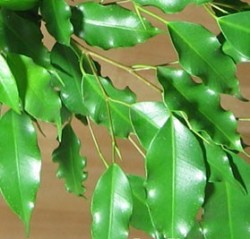
Indoor flower benjamin. Ficus benjamina - a plant with glossy leaves
ficus benjamina- one of the most popular decorative foliage indoor plants. His homeland is South Asia, Philippines, Australia. In nature, this is a large bush or tree, reaching a height of 8 - 10 m, in room conditions it grows up to 1.5-2 meters. The trunk is gray with small strokes. Branches inclined downward. Leaves on small petioles 2-2.5 cm, leaf blade oval with an elongated tip 4-8 cm long and 1.5-4 cm wide. The central vein is not clearly expressed. The sheet is dense, glossy. The color of the leaves varies from light green to very dark, there are many variegated forms.
Indoor varieties
Ficus benjamina has a huge number of varieties that differ in the size of the leaves and their variegation.
Variety "Daniel"- differs in very dark monophonic leaves.

Variety "Monique"- has more delicate, thin branches and a light, slightly wavy leaf along the edge.
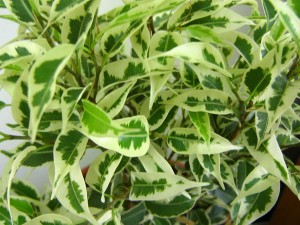
Variety "Nicole"- has a more elongated sheet with a light edge.
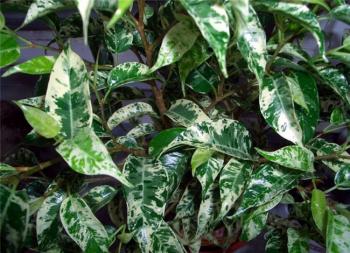
Variety "Safari"- differs in obvious spotting and tricolor coloring.
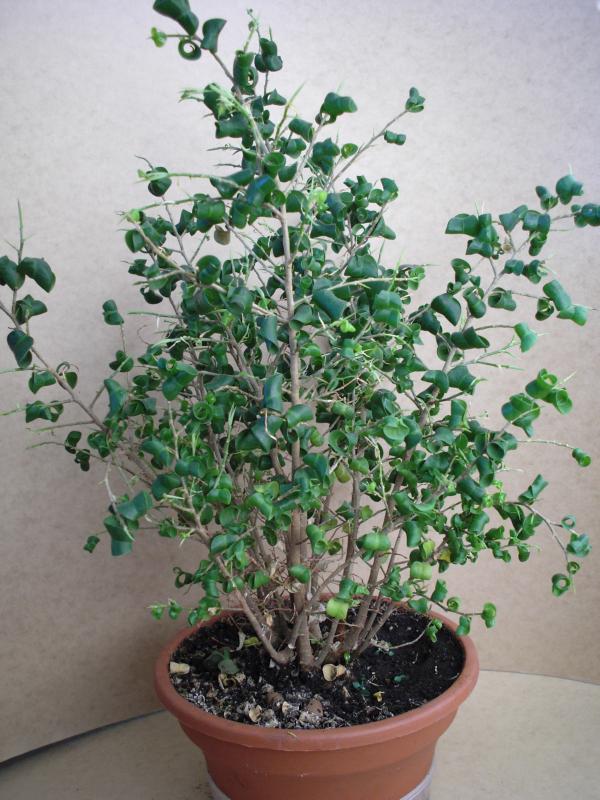
Variety "Baroque"- the most unusual and difficult to grow. Each leaf of this miniature plant is twisted into a spiral.
Care
Accommodation
Prefers bright, but not sunny places. In summer, it needs shading from direct sunlight, which can cause burns on the leaves. The required amount of lighting also depends on the variegation of the leaves - the more variegated, the more light the plant needs. If the ficus is in the back of the room, it needs to be provided with additional illumination with a fluorescent or phytolamp. It is desirable that the backlight be directly above the growth point, in which case the crown will be more symmetrical.
The plant does not tolerate drafts and responds to them by dropping leaves.
For the summer, ficus benjamen can be taken out to the balcony or garden in a place protected from wind and direct sunlight. However, in this case, after bringing the ficus into the room, due to sudden changes in the conditions of detention, it will shed some of the leaves.
Temperature
Prefers a temperature range of 20-25 ° C, in winter not lower than 15 ° C. Under the condition of proper watering, even higher temperatures are tolerated. Lowering the temperature below 15 °C will lead to mass leaf fall, and the temperature below 10 °C can lead to the death of the plant.
If the temperature in the room drops and it is not possible to transfer the ficus to a warmer room, the clod of earth should be well insulated. While maintaining the temperature of the roots, the ficus is able to tolerate lower temperatures for some time.
The plant should not be placed near heating appliances.
Watering
Water moderately after the topsoil dries out. The plant reacts to overdrying by dropping part of the leaves, from overflowing the leaves become light and the roots can rot. In winter, with a cooler content, watering is slightly reduced.
Watering is done with warm settled water. The water is drained from the pan.
Humidity
For more intensive growth, it is advisable to regularly spray with warm boiled or filtered water. However, the plant grows well without spraying, easily adapting to the conditions of the apartment.
Only in winter, in hot apartments with central heating, it is advisable to spray the leaves to avoid losing some of the leaves.
From time to time, it is advisable to wash the ficus in the shower to wash off the dust from the leaves. If the size of the crown allows, the crown can be completely immersed in water for a few minutes.
top dressing
From spring to autumn, ficus is fertilized with universal fertilizers for decorative leafy plants, diluted in a slightly lower concentration than indicated on the package.
In winter, with a cool content, top dressing is stopped; with a warm content, they are fertilized once a month with fertilizers diluted in an even lower concentration.
Fertilizers are added to the water for irrigation and watered over the already wet coma of the earth.
The plant responds well to Epin treatment, which stimulates faster crown growth.
Transfer
Young specimens are usually transplanted once a year in the spring, adults - once every 2-3 years, when the roots entwine the entire clod of earth. In large plants, it is permissible to replace the top layer of the earth instead of transplanting.
Pots can be ceramic or plastic, a layer of drainage is needed. The size of the pot should be only 2-3 cm larger than the previous one.
Universal store soil is suitable for planting, or you can make a mixture of peat, leafy soil and sand in a ratio of 1: 2: 1.
reproduction
Propagated by seeds, cuttings and air layering.
- seeds sown in the ground in the spring, covered with a bag and placed in a warm, bright place. Germination occurs within a month. After the appearance of two sheets, the seedlings are seated in separate pots;
- layering only rare and complex varieties of ficus benjamen are propagated, for example, the Baroque variety with twisted leaves. For propagation by layering, the bark is cut into a ring, wrapped in wet sphagnum, moistened and wrapped with plastic wrap. After the roots appear, the layering can be separated from the mother plant and planted in the ground under the bag;
- The easiest way to reproduce is cuttings. A stalk 15-25 cm long is cut off, placed for a couple of hours in warm water so that white juice comes out, after which the edge of the stalk is rinsed and placed in clean boiled water. It is advisable to put a piece in the water to prevent rotting. After the roots appear, the cutting can be planted in the ground under a bag or jar. When the cutting begins to grow, the polyethylene should be gradually removed, tearing it to gradually accustom the plant to the air in the room. Can be rooted directly in the soil under the package.
Diseases and pests
Growing problems:
- Leaves turn pale- insufficient lighting. Put the ficus in a brighter place or provide it with additional lighting;
- Leaves are pale and sluggish- you filled the ficus. Do not water the plant for a while. If this does not work, transplant it to another land, removing rotten roots and spill it with a solution of root;
- The plant sheds its leaves- the loss of part of the leaves in the fall is a natural process for ficus benjamen. If the plant immediately sheds a lot of leaves, it may be standing in a draft, or near a heater. Move the plant to a different location.
crown formation
Ficus benjamina is a fast growing plant that requires crown formation. If the plant is standing near a window, it is advisable to rotate it by 90 ° C every 2 weeks in order for the crown to grow evenly. But this is usually not enough. The plant needs annual spring pruning.
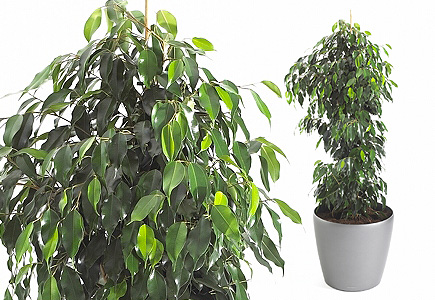
It easily tolerates pruning, which stimulates the formation of numerous side shoots. Pruning is usually done over a sleeping kidney, blotting the cut with a cloth and sprinkling it with charcoal. If the plant is small, you can pinch it - simply by removing the growing point.
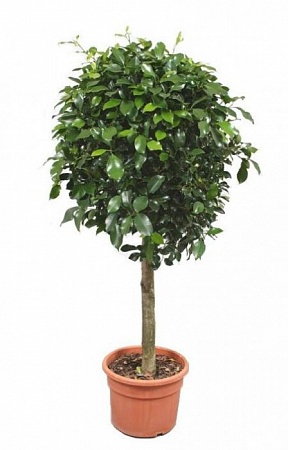
From ficuses can be formed standard plants, removing the lower branches and forming a dense crown with pruning.
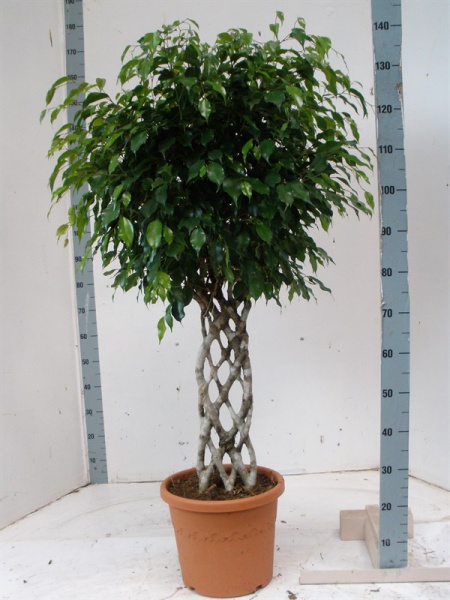
A very interesting effect can be achieved by intertwining the trunks of several plants. To do this, several young ficuses are planted and their trunks are intertwined. The bark is incised at the points of contact between the stems. As a result, plants grow quickly. In this way, you can form completely unusual openwork trunks.
Ficus is one of the most popular indoor plants. He perfectly adapts almost at home, although he himself comes from tropical latitudes. There are many varieties of this type of plant. The most popular among the rest is Benjamin's ficus. Care at home does not require much effort, but compliance with the basic rules of maintenance is mandatory.
plant description
ficus is one of the most popular indoor plants
Decorative ficus is a small tree. Characteristic is a shortened trunk, covered with a smooth grayish-beige bark, a branched crown.
The plant comes from the tropics, so the root system forms branches under, above the ground. Numerous aerial roots act as an additional support. The formation of a banyan is possible only with a sufficiently high humidity. In drought conditions, aerial roots practically do not form.

ficus feels great in a dark place from direct sunlight
In its native lands, the tree grows to a height of 25-30 m. The maximum height when kept at home or in the office is 2-3 m. Foliage is of medium density with a dark green core, light, grayish-white edges. Because of this coloring, Benjamin's ficus is also called variegated. Each leaf, having an oval shape, a pointed top, reaches a length of 7-13 cm, a width of 2-6 cm.
Indoor species do not differ in large sizes, but please the eye with a neat deciduous crown. Thanks to its variegated color, the plant is able to enliven any interior.

with the help of ficus Benjamin, the interior of the living room looks cozy at home
Features of home care
At first glance, the flower is quite unpretentious, but in order for the tree to be healthy and beautiful, a number of simple recommendations should be followed. What should be the care at home for ficus Benjamin.
Soil properties and varieties
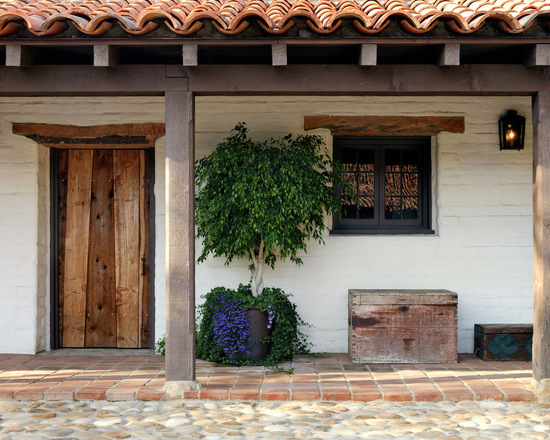
in warm weather, Benjamin's ficus will become a bright decoration of the facade of the house
As with all indoor plants, the quality of the soil plays a big role. You can use special soil purchased at the store. However, the best option is to make it yourself. As Benjamin's decorative ficus grows, it will be necessary to change not only the soil lump itself, but also to regulate its composition.
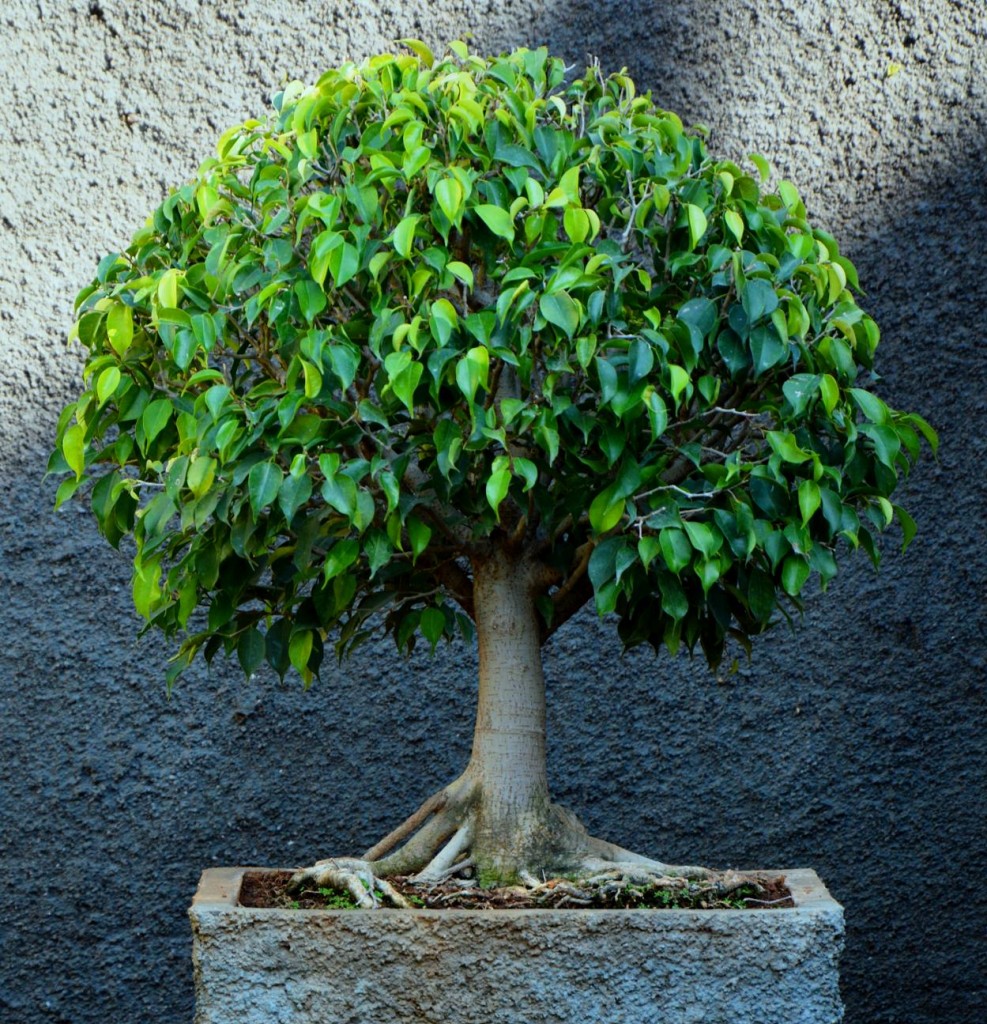
Ficus Benjamin attracts with its decorative effect and unpretentiousness
The proportion of the main components is determined based on two criteria:
- flower age;
- its size, in particular, the volume of root branches.
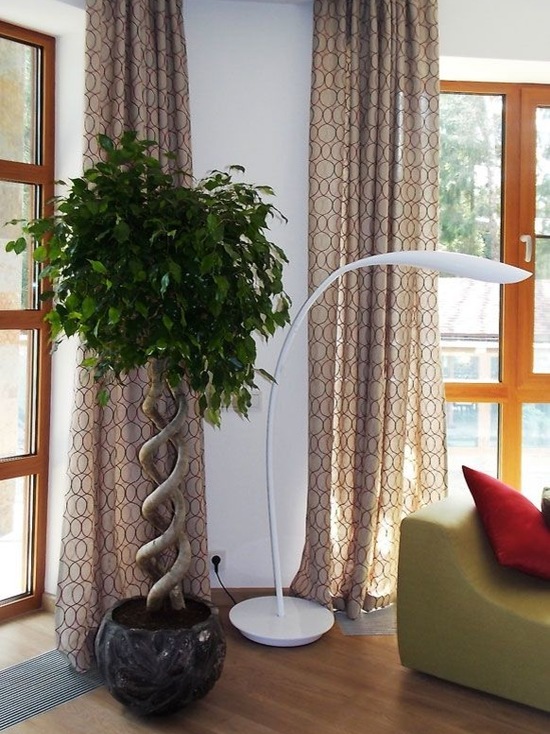
ficus should be placed in a ventilated area
Depending on the age of the houseplant, the optimal ratio is:
- For young trees, the proportion is 1: 1:
- part of leaf humus;
- part of fine river sand;
- part of the peat.
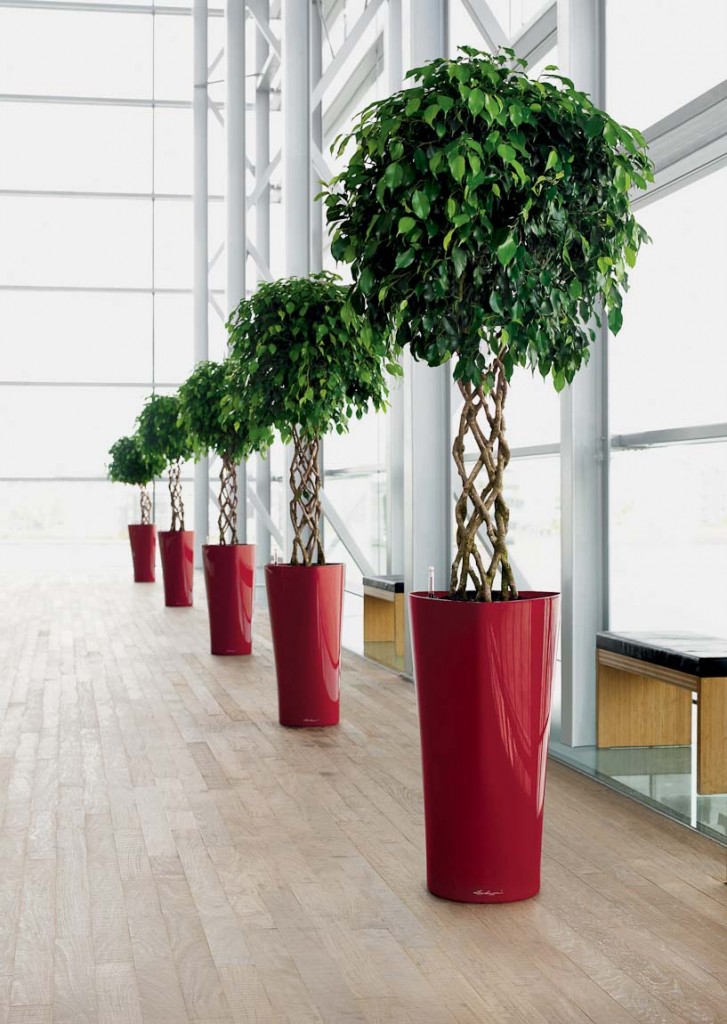
tall ficus trees in large flowerpots are exhibited in non-residential premises: offices, hospital halls, etc.
- For mature plants, there are two options for the soil mixture:
- a portion of sifted sand, 2 portions of leaf humus, 2 parts of sod land;
- one part of sand, leaf, sod land, peat.
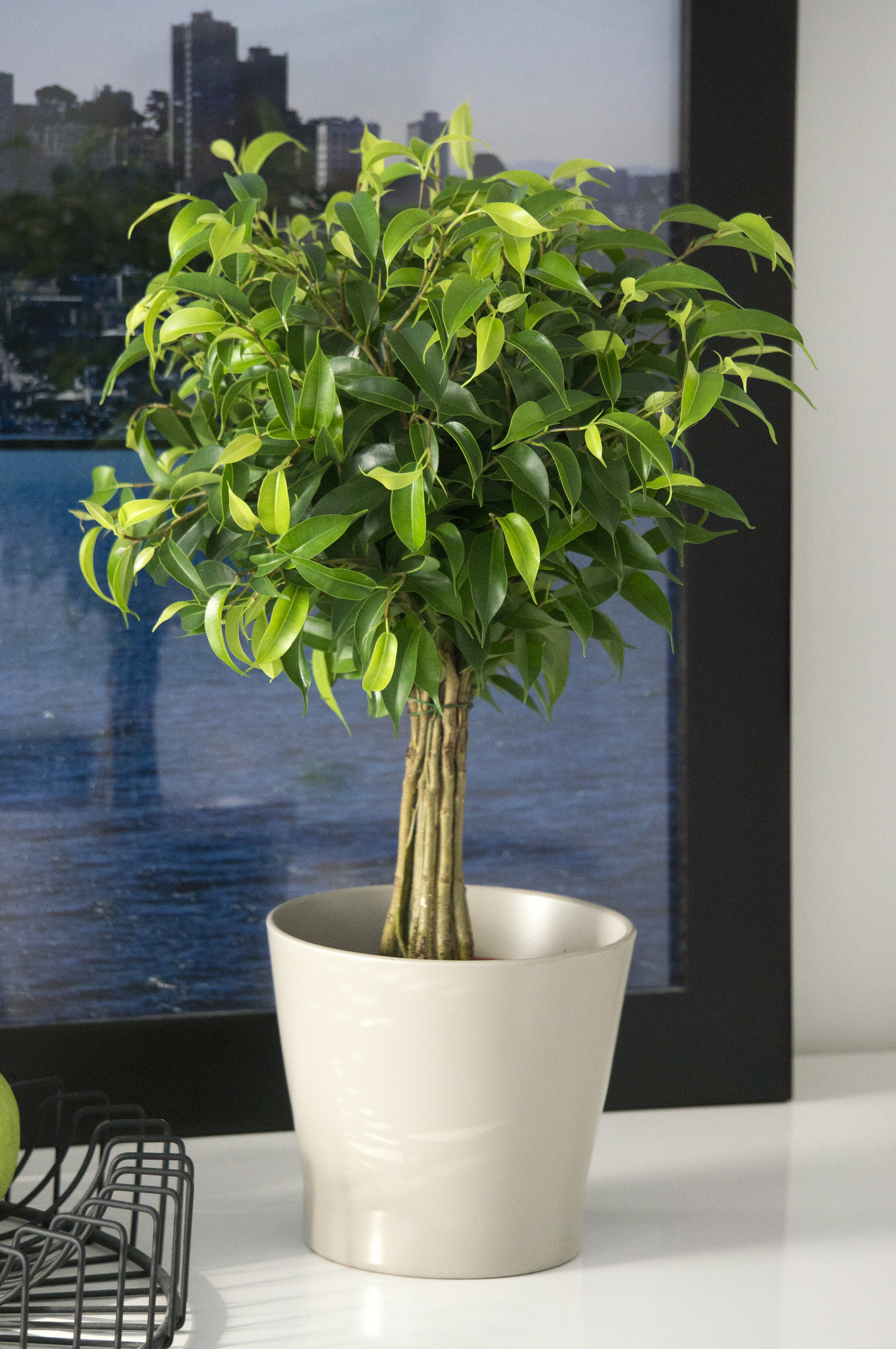
as the ficus grows, the composition of the soil should be adjusted
To make the soil lighter, looser, it is good to add a little coarse sand to the mixture. This soil consistency helps to strengthen the root system of indoor ficus Benjamin, the care of which involves maintaining optimal humidity, both in the soil itself and in the surrounding air.
Expanded clay improves the air permeability of the earth. When watering, fertilizing, the material absorbs excess liquid. Accumulating moisture, expanded clay feeds the root system of a houseplant with it when the soil layer dries up.

an adult ficus tree fits perfectly into the design of a spacious living room combined with a kitchen
In order to enrich, as well as loosen the earth, crushed charcoal or ash is added to the mixture. To feed the roots, biohumus, which is a waste product of earthworms, is used as an organic fertilizer, a natural growth stimulator.
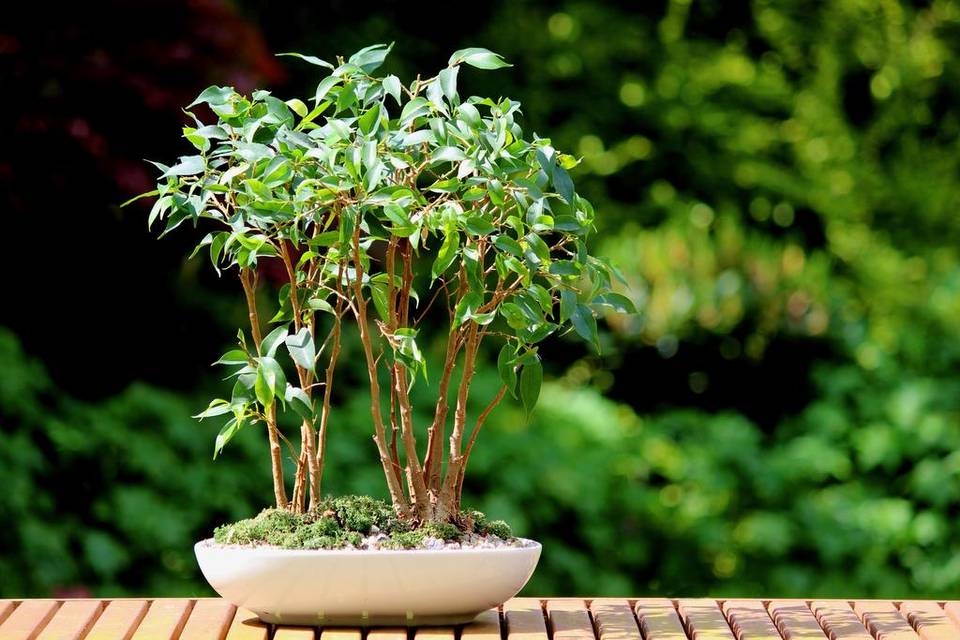
when transplanting a ficus, its root system goes through an adaptation period
Correct layering
When preparing the soil mixture on your own, it is necessary to take into account the rules for compiling components, laying layers depending on their density.
At the bottom of the pot, be sure to lay out drainage from expanded clay. The size of the fraction is determined depending on the volume of the container for planting. The larger the bottom area, the larger the expanded clay should be.
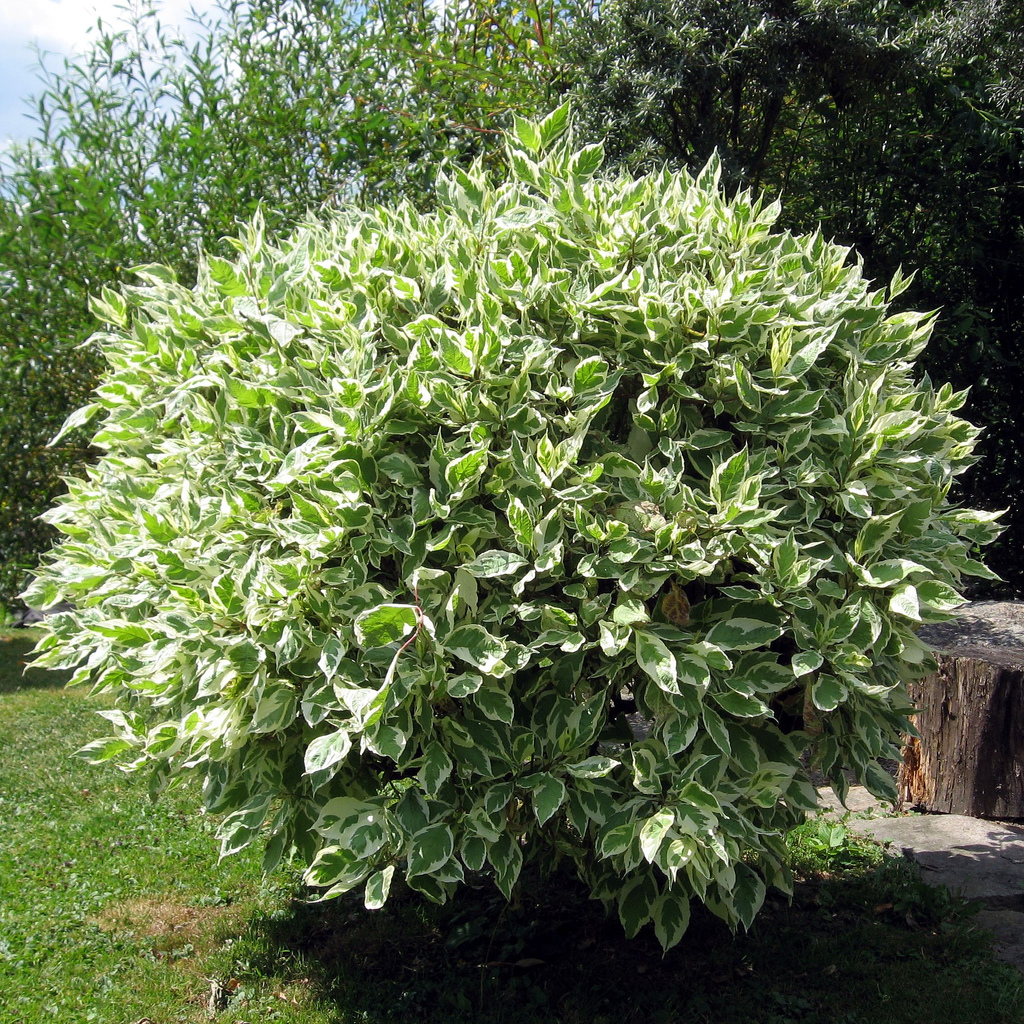
ficus growth depends on self-prepared soil mixture
Effective drainage can be made from charcoal by laying out one layer of particles of the same size. Coarse-grained sand is also suitable. However, if it is used, the bottom of the pot must be covered with a net so that sandy drainage does not spill out through the holes.
The next layer is a substrate prepared by one of the above methods. Approximately 2/3 of the volume of the pot is filled with the main mixture, the remaining third with a lighter layer. This may be land with a high content of peat, fine sand, ash.
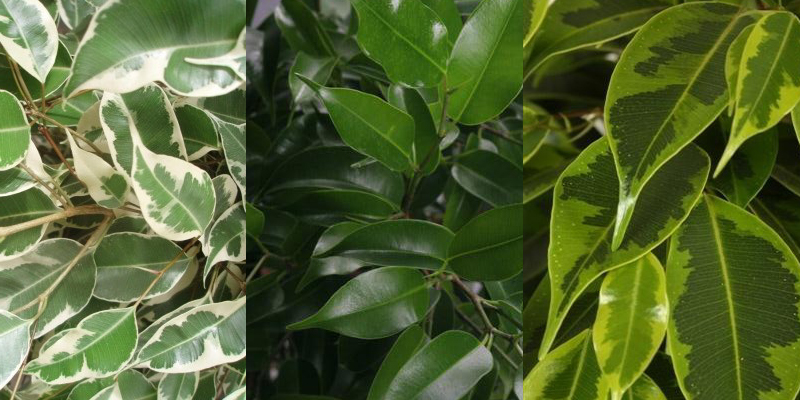
varieties of ficus Benjamin: kinki, natasha, nicole
In the hot season, a layer of fine expanded clay is sometimes laid on the surface of the earth. After watering, it retains part of the moisture inside the particles, gives it away if necessary, preventing the earthen clod from drying out.
How to choose the right soil mix
There are countless different substrates on the shelves of specialized stores. Among them are presented, both universal mixtures and those formulated taking into account the characteristics of indoor ficus Benjamin.
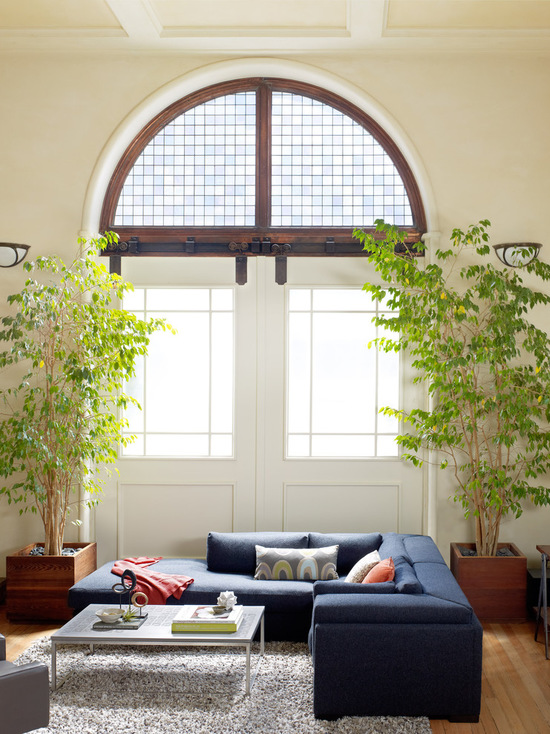
decoration of the recreation area with two parallel ficuses
One rule to keep in mind is that most ready-made soil mixes are not intended to be used as a stand-alone soil for planting. They are recommended to be added to ordinary soil, improving the breathability and moisture absorption of the layer. Failure to comply with this rule in most cases leads to a deterioration in the condition of indoor ficus and even to its death.

Ficus cultivar de dumbbell contrasts against the background of green vegetation
When choosing a finished substrate, you should pay attention to the composition. Conscientious manufacturers always indicate the list of components on the packaging. The main components of the mixture necessary for the effective growth of ficus Benjamin are:
- peat (high, lowland);
- river sand with different particle sizes (coarse-grained, fine-grained);
- expanded clay of different fractions (small, medium, large);
- a complex of fertilizers (mineral, organic).
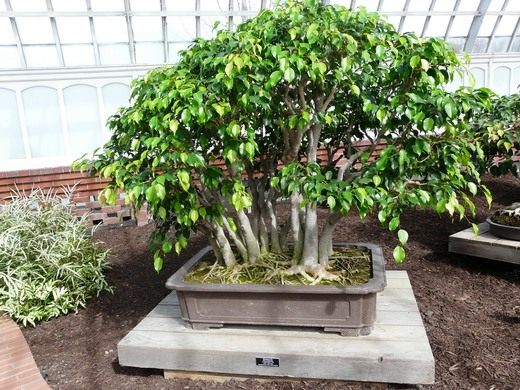
ficus benjamina can be kept outdoors at an air temperature of at least + 16C
You can carry out the initial planting in the finished substrate, adjusting its composition after some time. After 2-3 weeks, according to the condition of the leaves, the crown can determine whether this soil is suitable for the plant.
If indoor flower does not shed foliage, has a rich color - the soil composition is suitable. A change in color, drying of the edges of the leaves, wilting of the branches indicates unfavorable conditions. However, the problem may not be only in the ground.
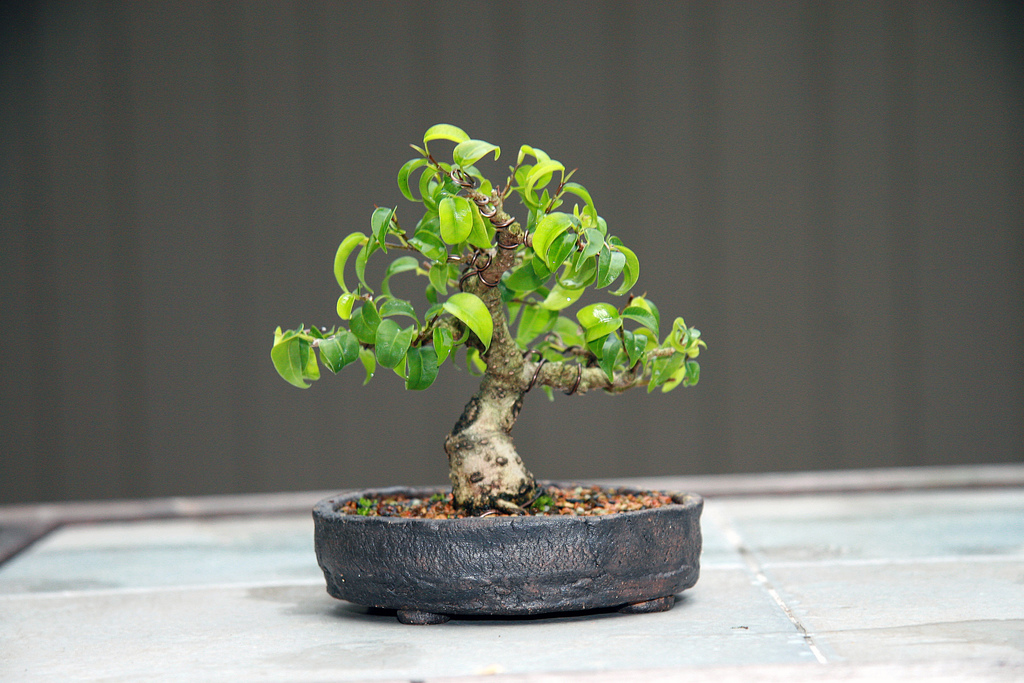
compact ficuses are an excellent choice for small apartments
Signs of unsuitable soil
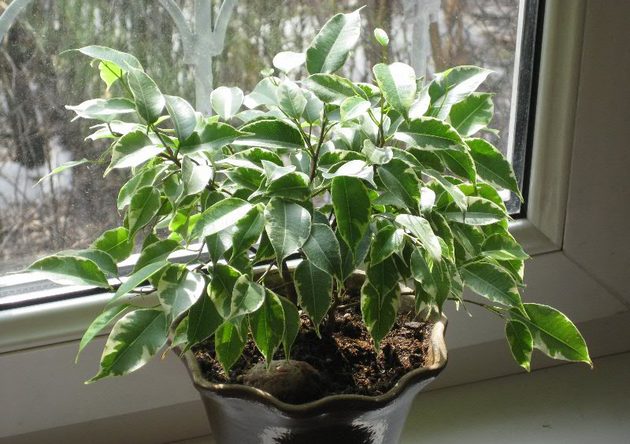
if indoor ficus sheds foliage, then the soil is not properly composed
The rapid drying of the soil layer indicates that the substrate contains a lot of peat. Too light and loose soil consistency leads to a lack of moisture in the roots. Drying out, as well as fluid stagnation, contribute to the development of diseases, the reproduction of pests, as a result of which the decorative ficus may die.

to give a spherical crown, young ficus shoots are pruned from February to May
Determining the condition of the soil is quite easy. It is necessary to carefully insert a long wooden skewer or stick into the earth layer. You can also check with your fingers. However, it should be remembered that it is recommended to work with the ground with rubber gloves. Easy penetration into the soil mixture to a depth of several centimeters is a sign of the correct consistency.

to create a comfortable seating area in the hallway, it is enough to place a small sofa, a lamp and a flowerpot with ficus
Moisture saturation is determined in a similar way. A wooden skewer or finger is immersed in the soil. If, after extraction, the surface remains moderately moist, with a small amount of earth, then the mixture is sufficiently moistened. Additional watering should be done when dry, light spots or cracks are visible on the top layer.
Soil replacement frequency
Young ficuses should be transplanted into a new substrate annually. Plants older than 3-4 years require soil replacement every 2-3 years.
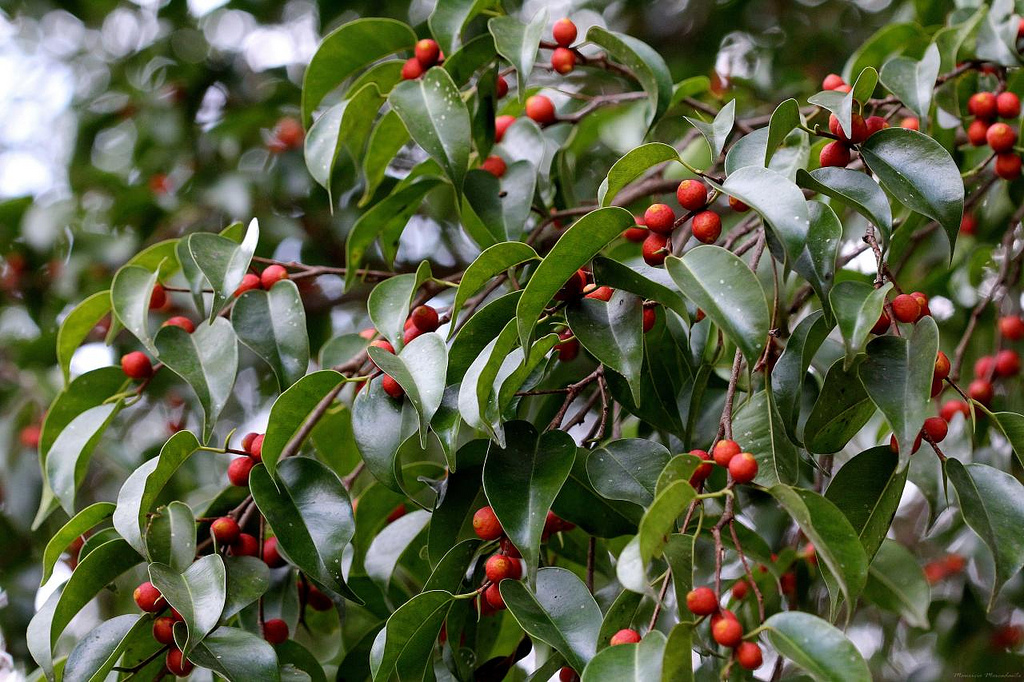
at home, it blooms extremely rarely; in nature, ficus inflorescences look like red peas
Optimal lighting mode
When caring for ficus Benjamin at home, it is important to organize the right lighting. The plant does not tolerate strong darkening and direct sunlight.
The lack of light can be determined by stopping the growth of the flower. The trunk does not lengthen, the crown does not increase in size, no new leaves are added.

ficuses will “revive” the cold interior of the bedroom
Exposure to direct sunlight causes the plant to shed its foliage. The branches are also noticeably drying up and withering. Even if the tree is provided with abundant watering during this period, it is not possible to improve its condition in most cases. The only way out is to move the pot to a place protected from direct sunlight.
The optimal location of the flower is a bright room with access to fresh air. It can be a balcony with blinds or curtains on the windows, an attic, a veranda and other options. Scattered light creates ideal conditions for the normal growth of ficus.
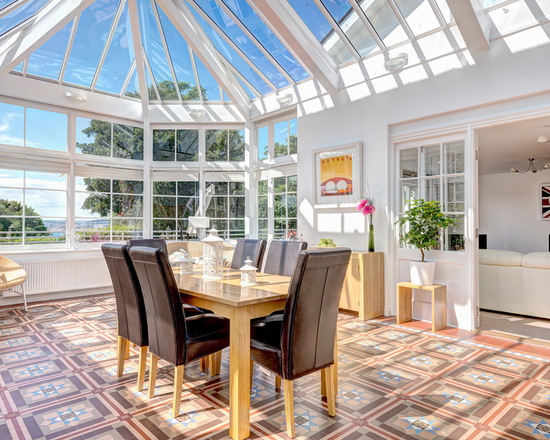
a small pot of ficus creates an oasis corner in a snow-white dining room
When the average daily temperature exceeds 15-16 degrees, it is useful to take the ficus out into the fresh air. In autumn, with the onset of night cold, the pot is transferred to a warm room.
Irrigation Features
This houseplant requires high humidity. Although, under the recommended lighting conditions, it calmly tolerates short periods of drought. For example, when the owners leave, on especially hot summer days.
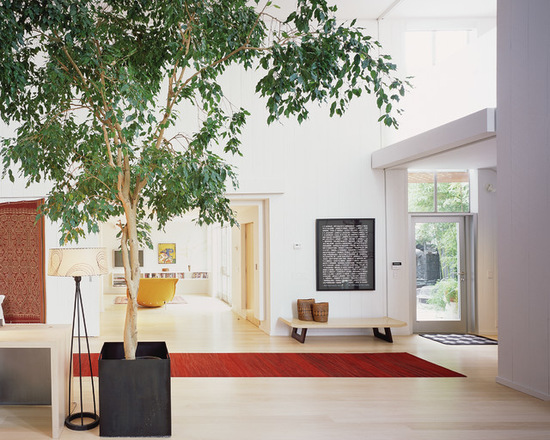
high voluminous ficus looks great in spacious rooms with high ceilings
The period of intensive growth lasts from mid-April to October. At this time, it is necessary to provide the tree with abundant watering and high humidity. The topsoil must be constantly moist. To do this, it is recommended to water the plant every other day, with a small amount of settled water, distributing it evenly over the surface.
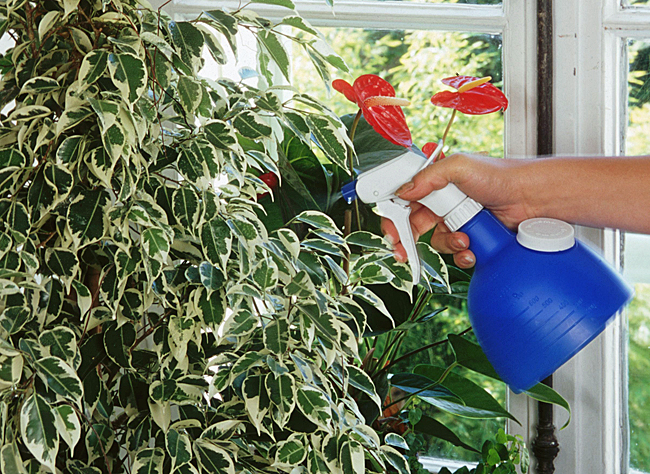
from April to October, Benjamin's ficus needs abundant watering
In hot weather, the edges of the leaves often dry out, which worsens appearance plants. To avoid this, the crown must be sprayed with a spray gun. On especially dry days, when the air humidity is at its lowest, it is useful for a tree to arrange a shower.
To do this, the root part must be covered with a layer of polyethylene so that water flows do not erode the surface of the earthen clod. The protective coating should be tied to the trunk with an elastic band or cord, completely covering the pot with it. Put the plant at the bottom of the bath and turn on the shower, directing the streams of water to the crown of the tree.

Benjamin's ficus complements the eco-design of the bedroom
This procedure has a beneficial effect on the flower:
- dust is washed off the surface of the leaves;
- improved moisture inflow;
- increases the air permeability of the foliage.
A shower for indoor ficus Benjamin can be arranged no more than once every two weeks and only in the summer. You can also carry out this procedure if the plant needs to be restored after exposure to the sun or in a hot, stuffy room. In this way, moisture can be replenished quickly and efficiently.
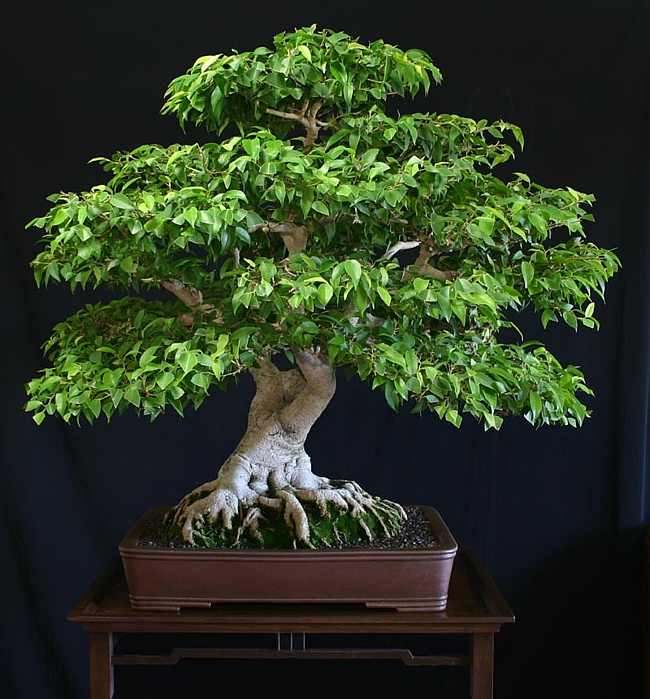
transplanting ficus is best in spring and summer
Starting in October, watering should be limited to once or twice a week. In this case, it is better to put the pot away from heating appliances. Dry, warm air harms the foliage, contributes to the deterioration of the general condition of the tree.
Until April, it is enough to irrigate according to the following scheme:
- Once a week, pour enough water into the pot so that a smaller part of it flows into the pan. This will be a sign that moisture has passed through all layers of the soil.
- Additionally, 3-4 days after the main watering, evenly spray water with a spray gun over the entire surface of the earth. Thus, the top layer will not dry out, which is an important condition for maintaining the health of the plant.
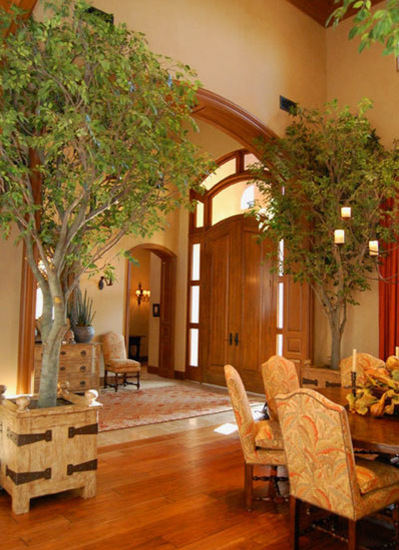
ficus Benjamin in the living room decorated in a classic style
At the end of the winter period, the tree crown often becomes lethargic, even if all the recommendations and rules for caring for Benjamin's ficus at home are followed. If there is no massive leaf fall, then this may be a sign of a lack of nutrition. Normally, plants, like humans, are deficient in nutrients at the end of the autumn-winter season.
make-up
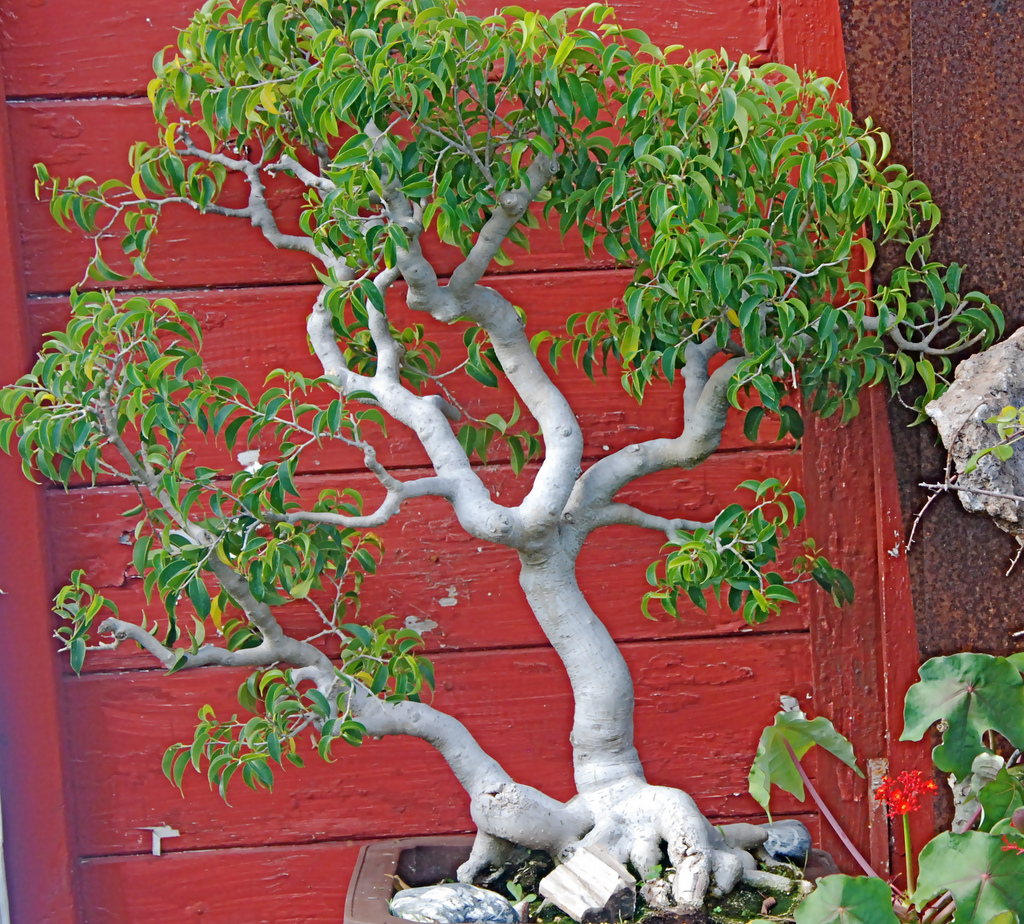
in spring, the soil must be nourished with mineral fertilizers
- Feeding the tree is important to carry out in moist soil.
- It is optimal to use mineral, water-soluble fertilizers.
- Avoid getting the nutrient solution on the roots and trunk of the tree. This may cause a burn.
- Feeding is enough to carry out once every two weeks.
For the period from April to October, the decorative ficus will be nourished and store the necessary nutrients for the whole winter.
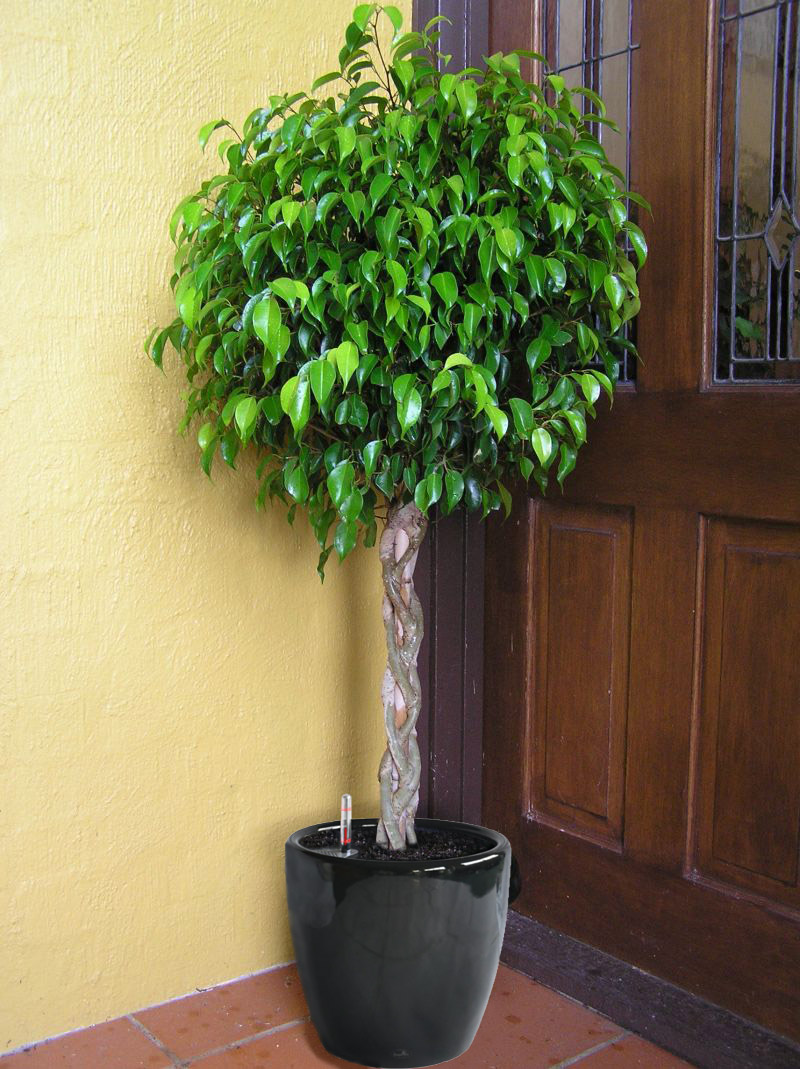
large pots of ficus with a spherical crown of leaves are best placed in the corner
Correct transplant rules
It is best to transplant the plant in May-June, when it wakes up and adapts a little to the summer light regime. However, you should have time to carry out the procedure before the onset of heat.
The best way is transshipment. Execution Method:
- Separate the earthen ball from the walls of the pot. If the container is plastic, it is enough to knead it a little by pressing on the side surfaces.
- Prepare a pot 2-3 cm wider in diameter than the previous one.
- At the bottom of the new container, arrange drainage.
- Release the root part of the flower, remove it from the pot by pulling the stem.
- Place the roots in a new container.
- Fill the free space with soil mixture.
- Seal the surface with your hands.
- Moisten the ground.
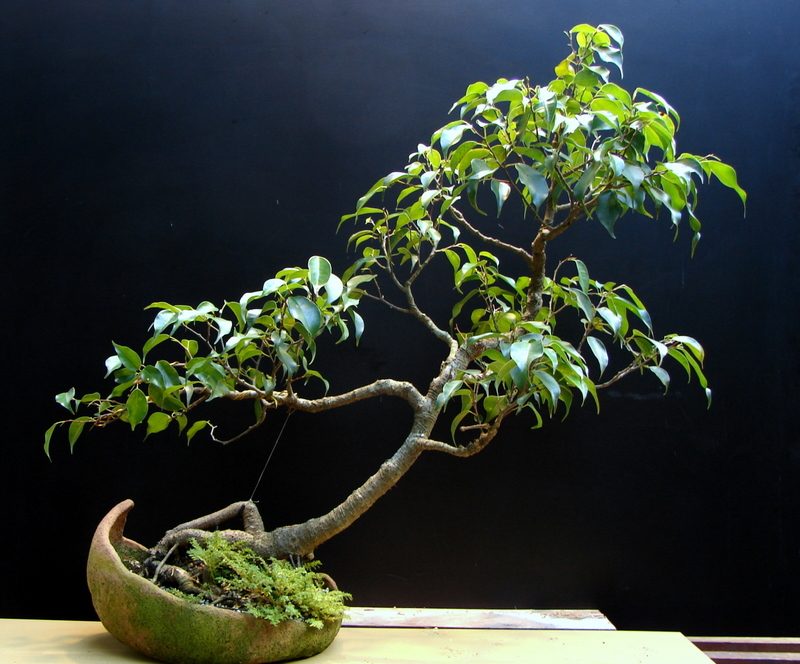
ficus does not tolerate drafts
For adult plants, provided that the diameter and depth of the current pot correspond to the size of the root part, it is enough to replace the topsoil. Approximately 2-5 cm of earth is carefully removed with a spatula. The vacated place is covered with fresh soil and moistened. The procedure is recommended to be carried out in the spring.
Pruning and propagation
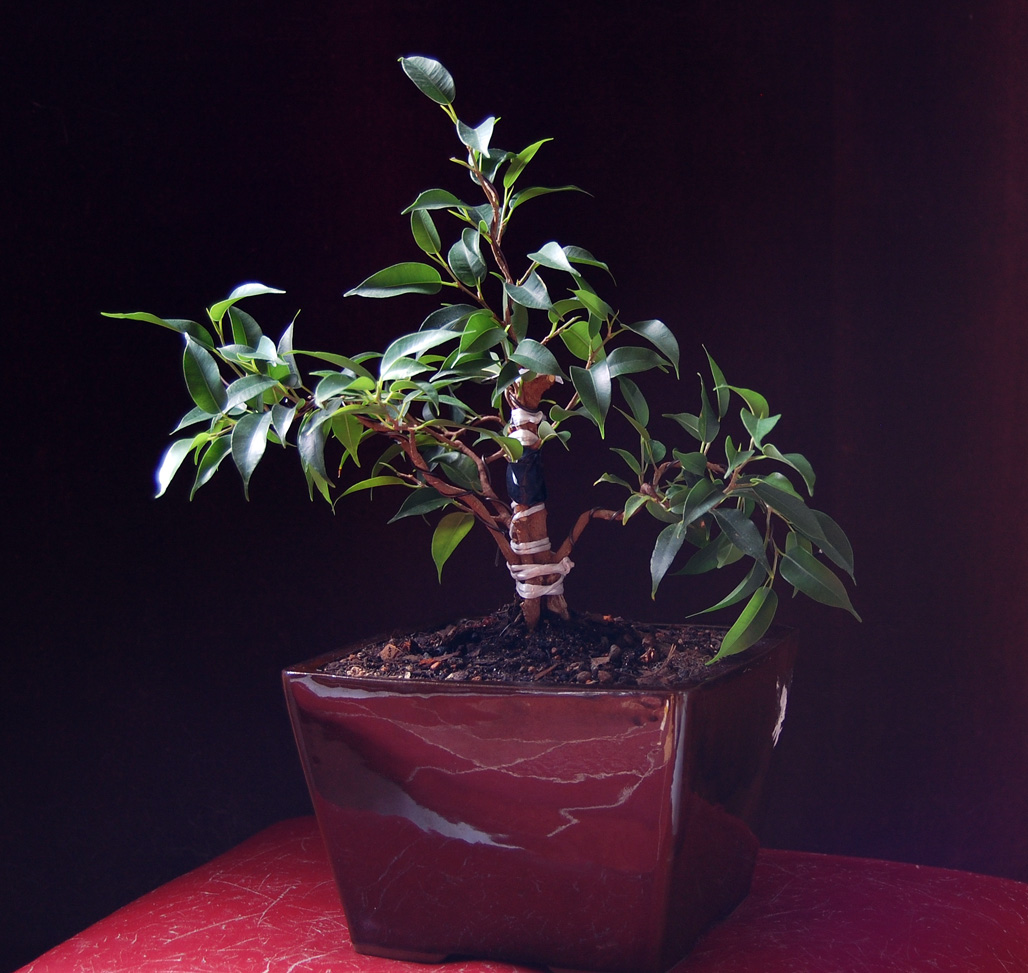
small pots with ficus can be placed anywhere
If the crown of the tree has grown enough, it is worth trimming the branches a little for better growth. To do this, use a garden pruner or a sharp knife.
The tops of the branches should be cut off, leaving a few leaves. Then the cut cuttings can be used for propagation. Pruning is best done in warm weather, optimally from May to September.
The stalk should be placed in a moistened cotton swab or gauze. When the shoot takes root, it should be dug into the soil of a light consistency and wait for germination.
Photo Gallery: Ficus Benjamin
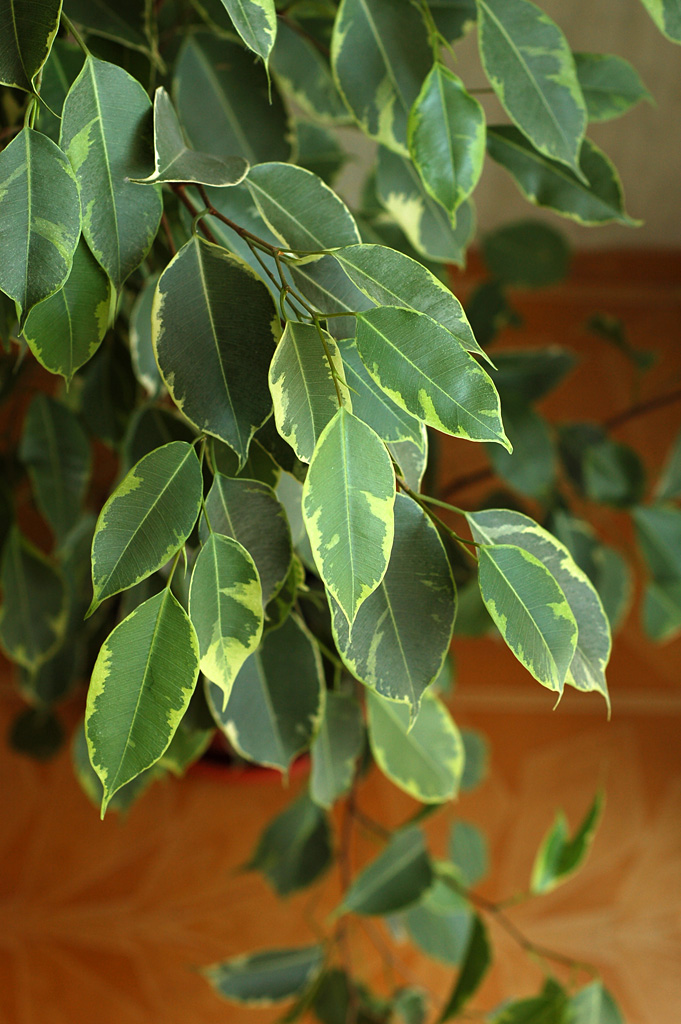
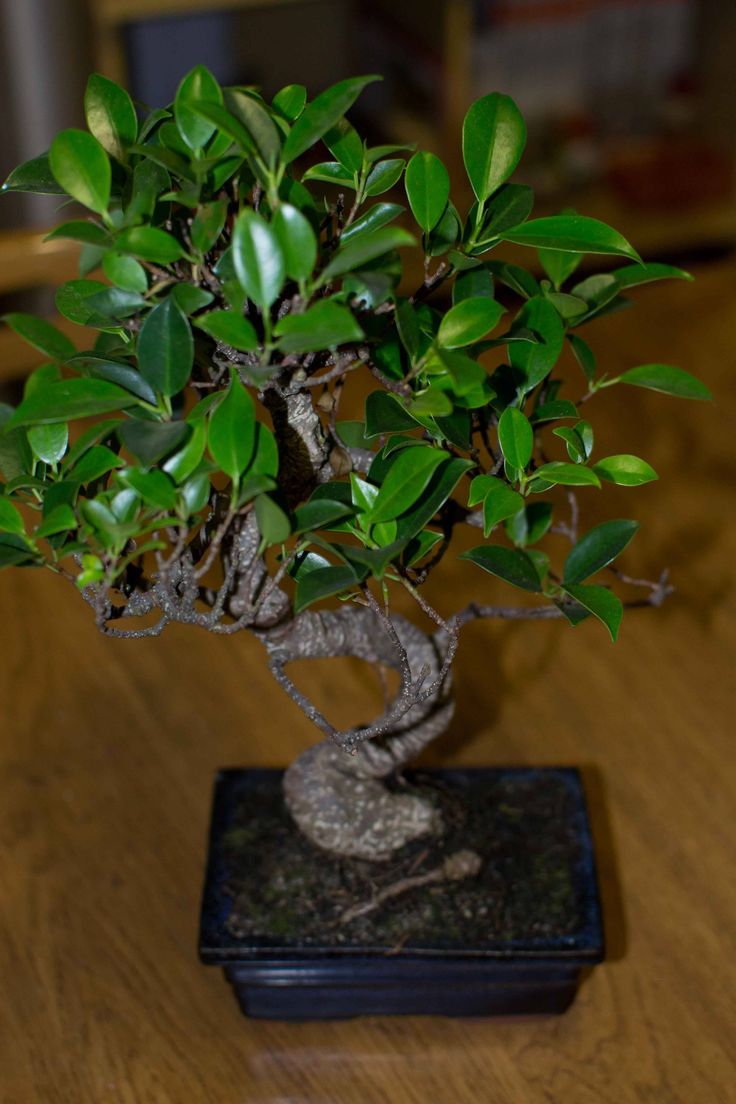
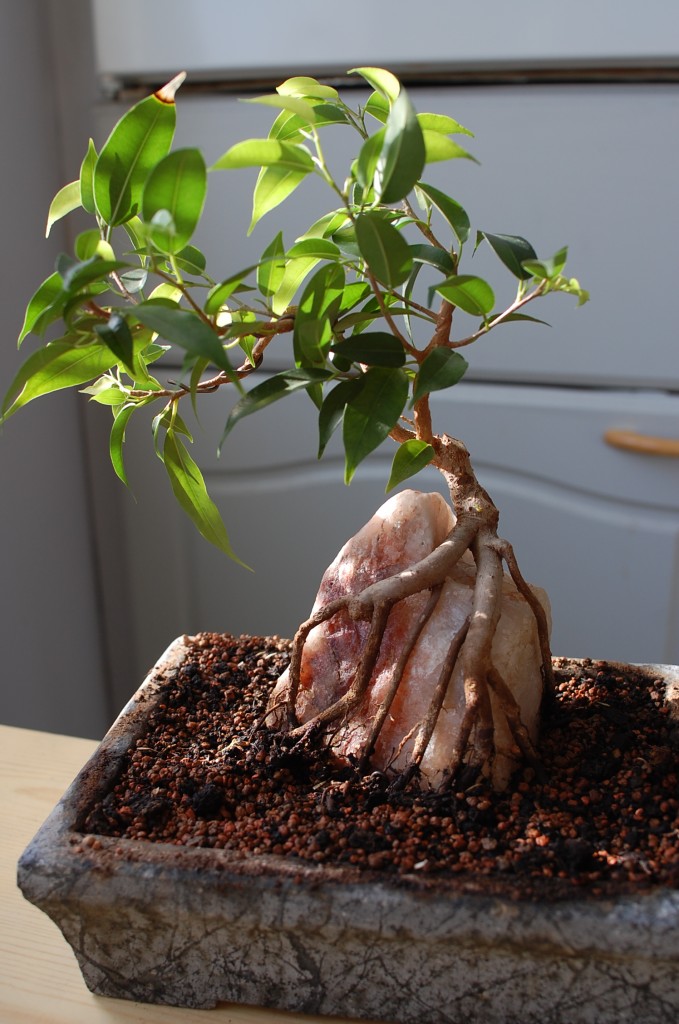
![]()

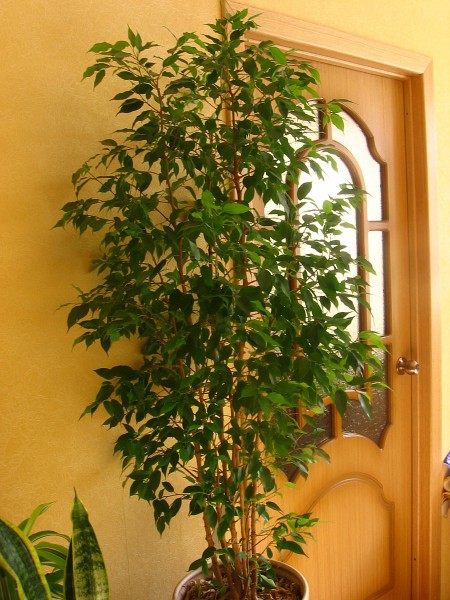
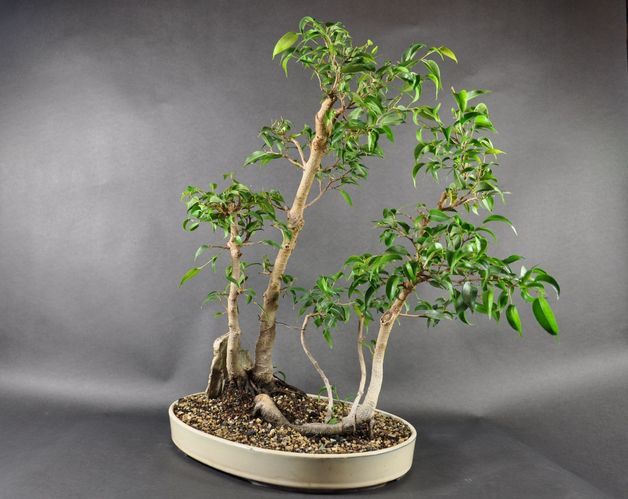
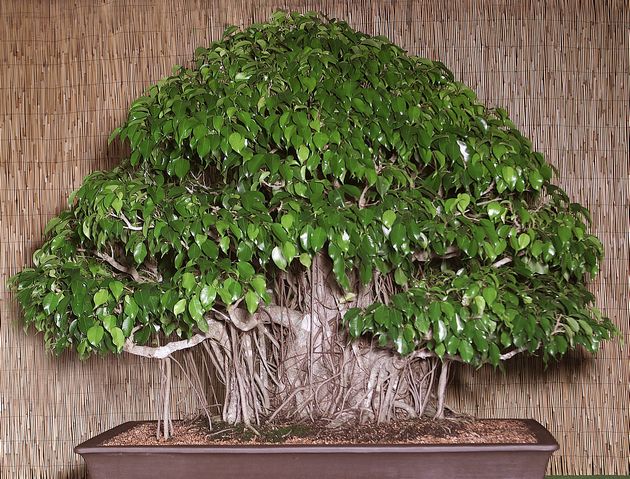
![]()
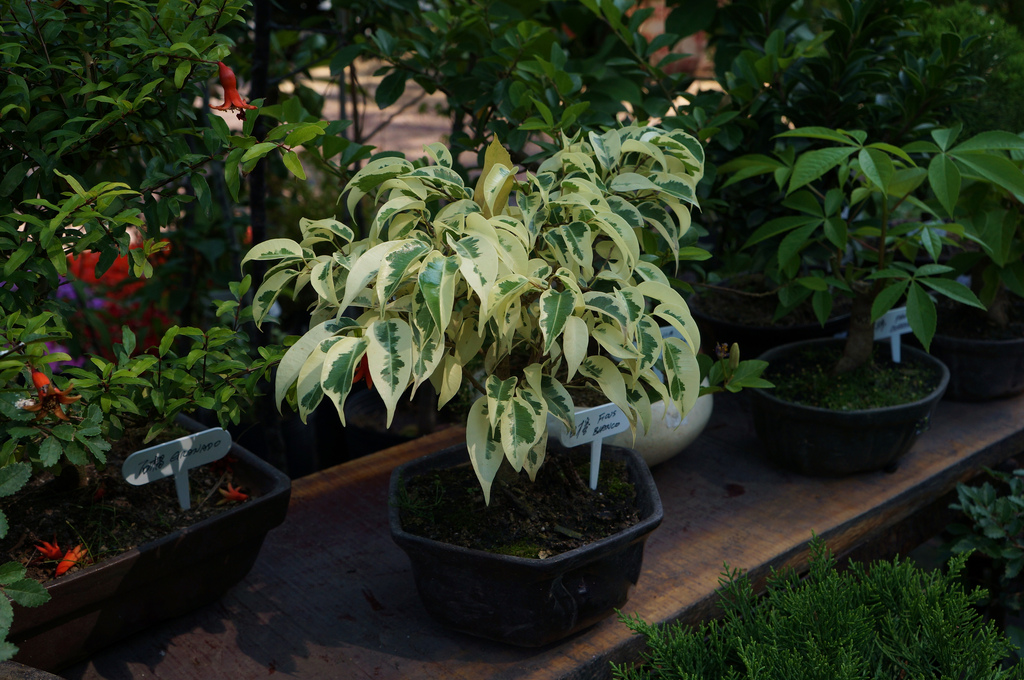



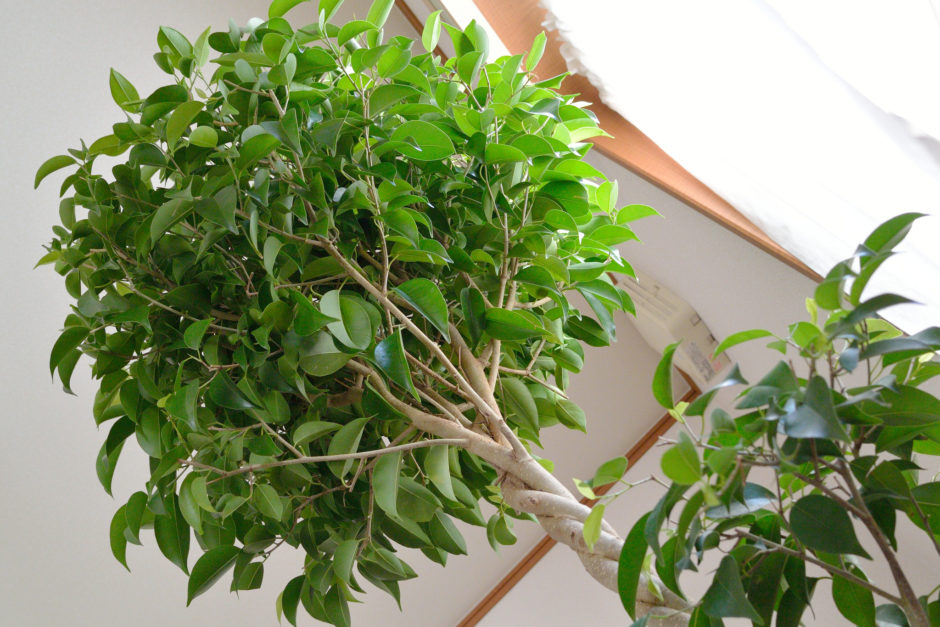
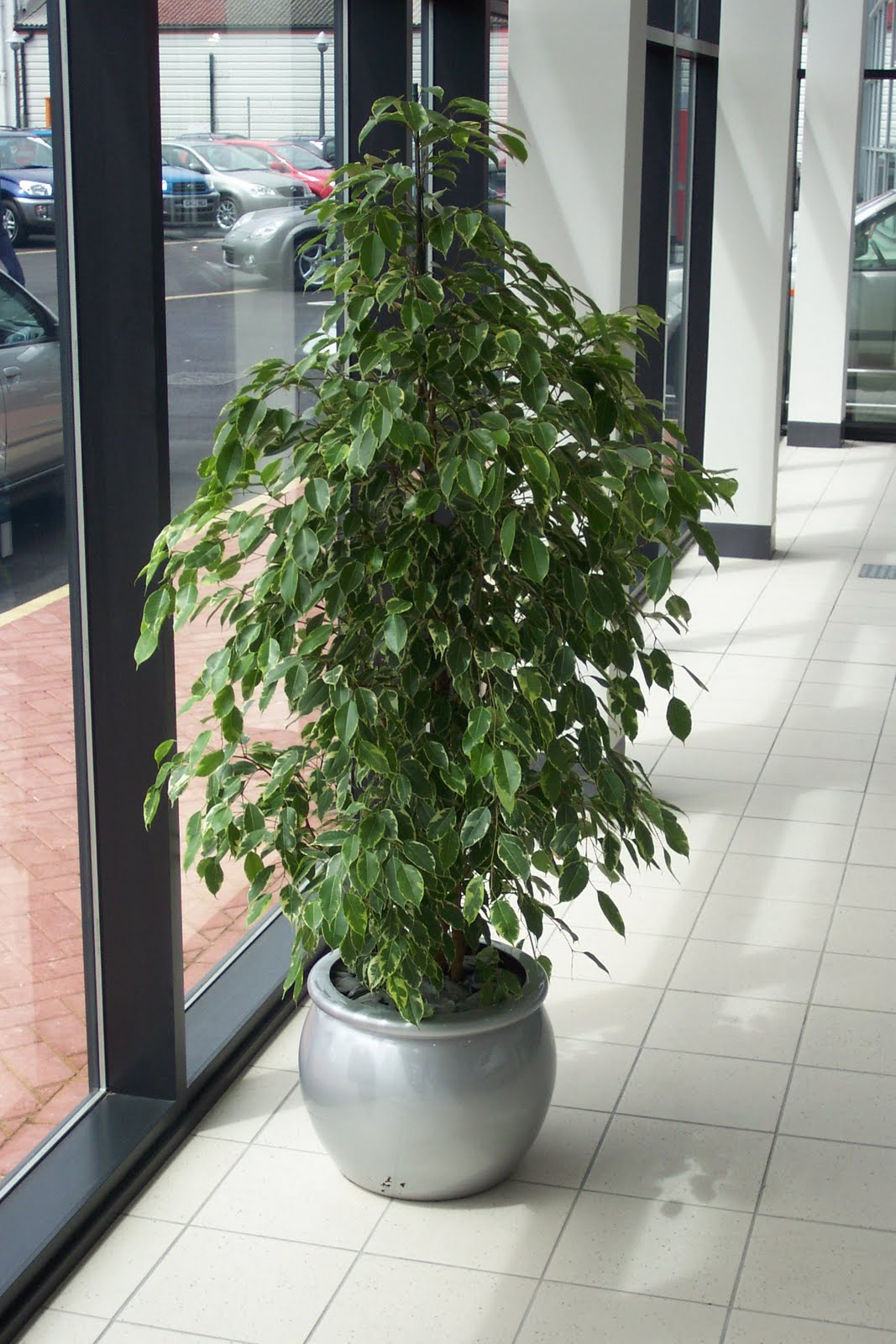
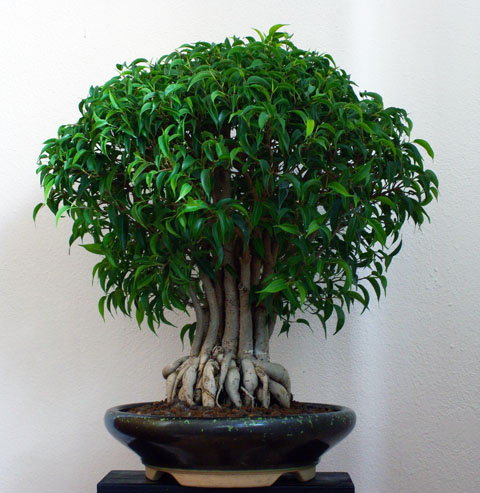
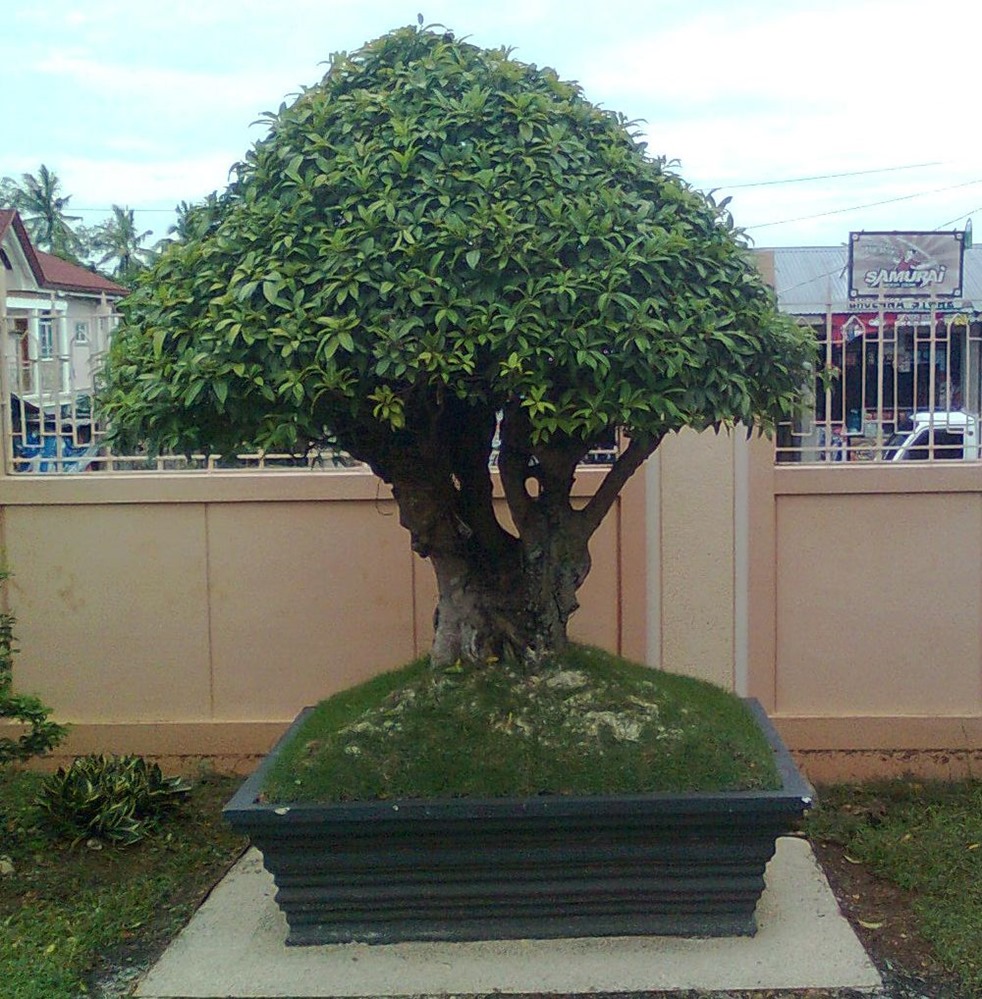
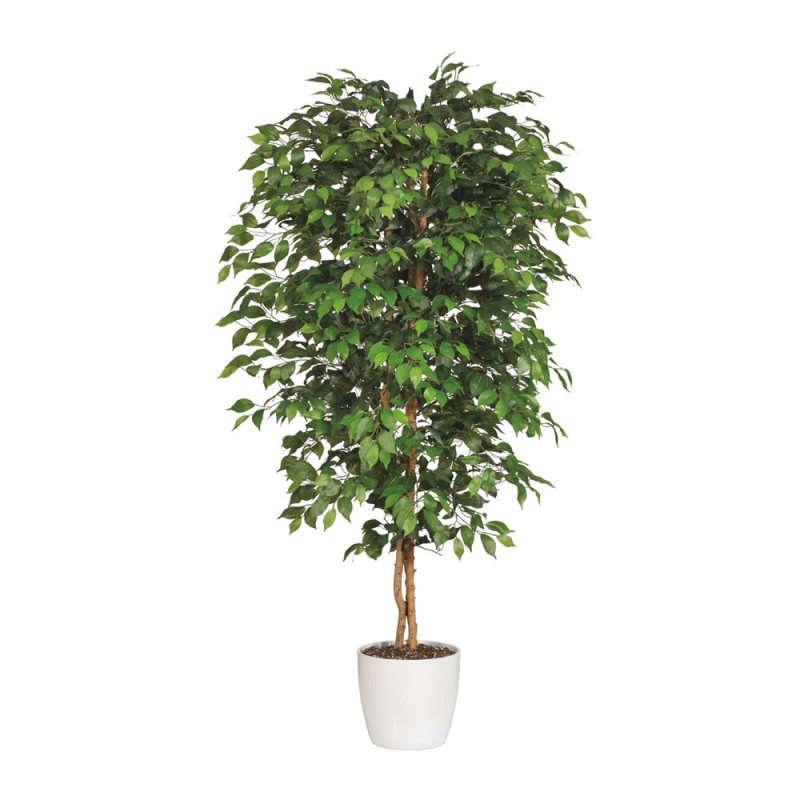
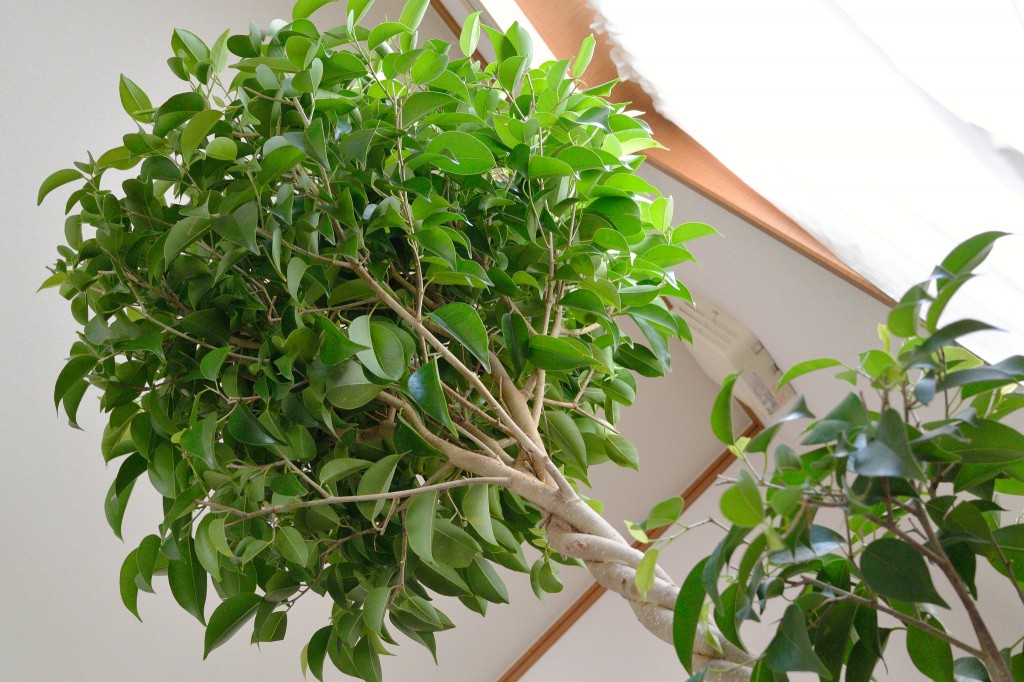

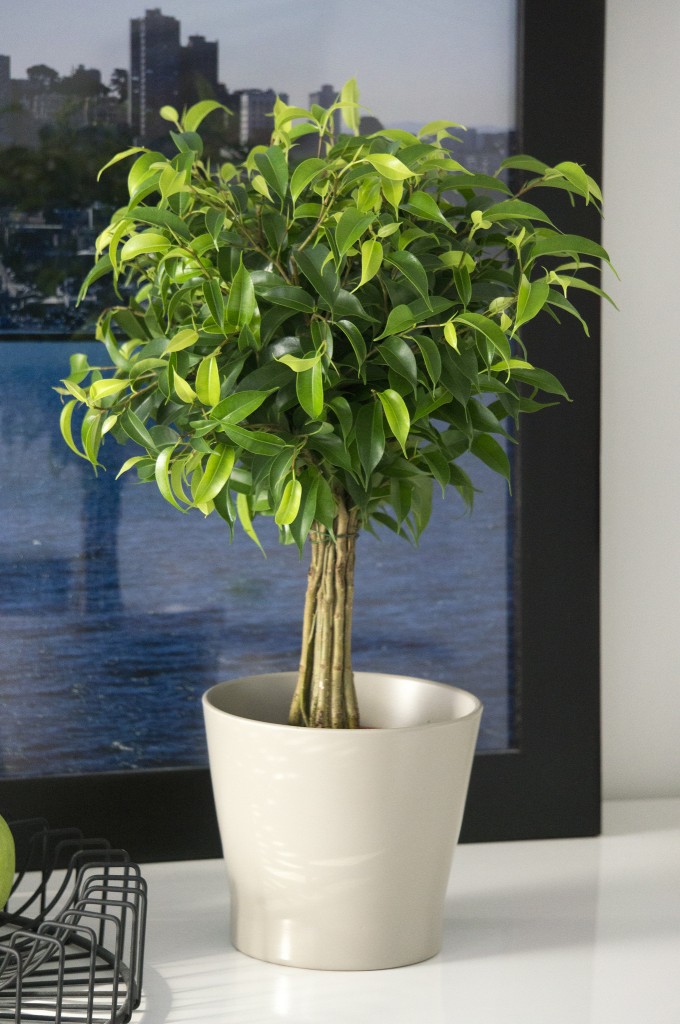
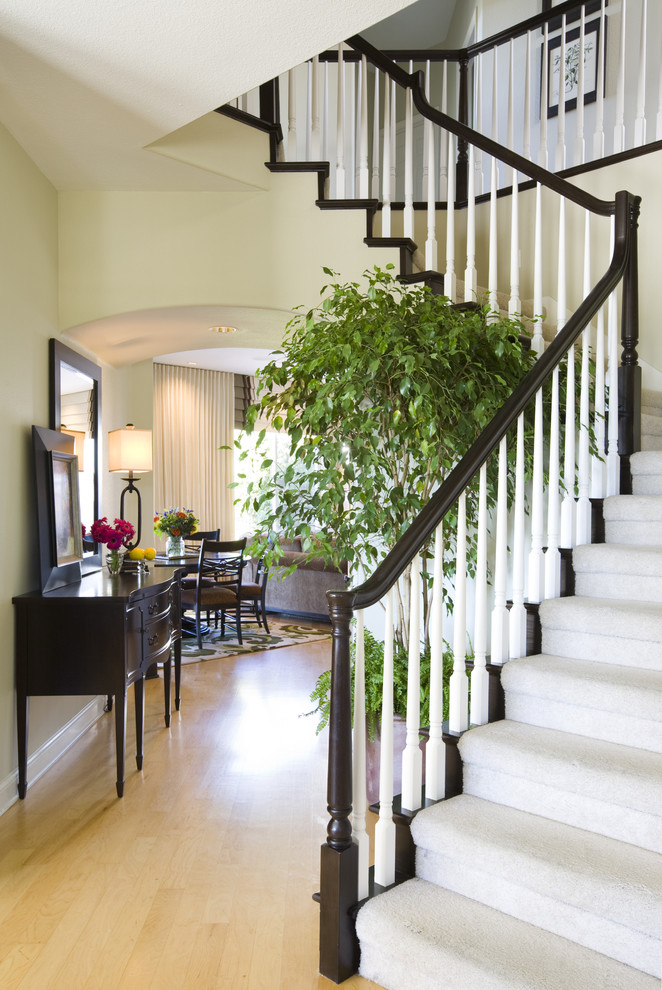

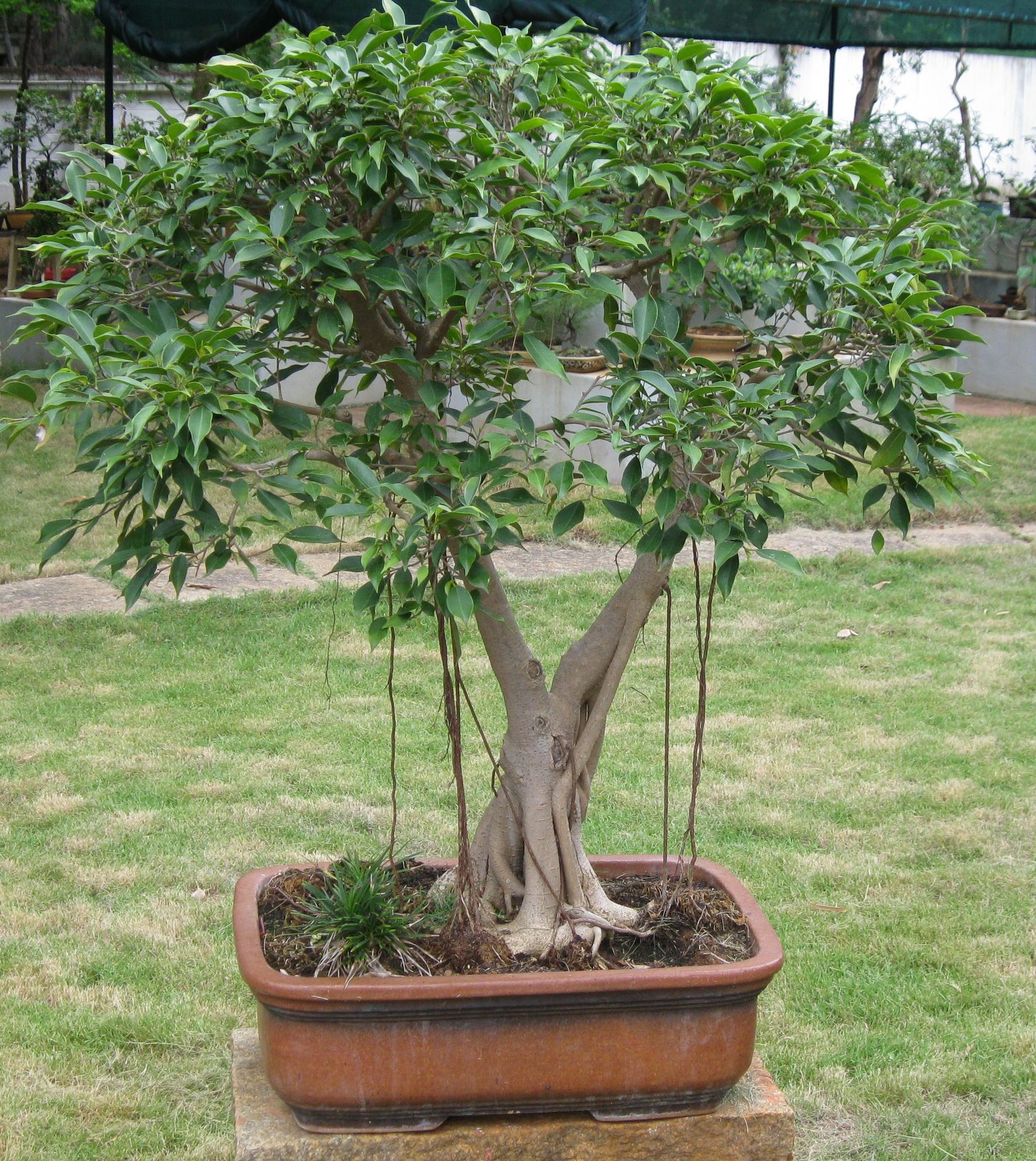
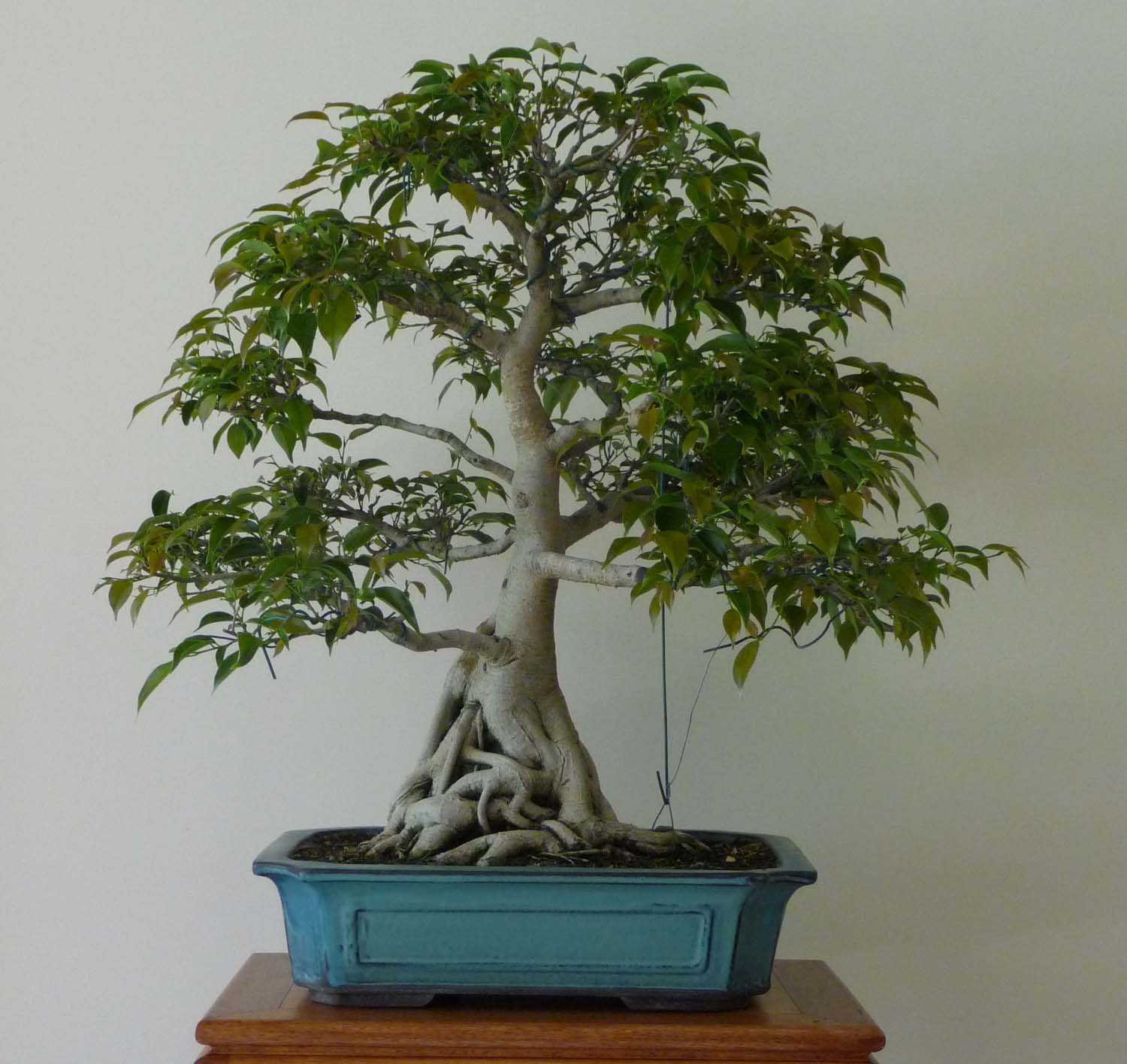
Ficus Benjamin in vivo is characterized by large sizes trunk and leaves. He lives in South Asia, where this plant can reach a height of up to two tens of meters. Regardless of care, Benjamin's ficus at home does not grow to such a size, allowing us to admire it without leaving for the Mediterranean or South Asia. Let's look at how to care for Benjamin's ficus so that for many years it will delight us with its fresh leaves.
Benjamin's ficus care must begin with the right choice of soil for planting. Benjamins love soils with low or neutral acidity. If you have the opportunity, you can mix the soil for the plant yourself.
For this, turf, leafy soil, sand and wood ash are taken in a ratio of 1: 1: 1 / 2: 1/8. Also, a soil based on the same components with the replacement of ash with one part of peat will be a good option for soil for ficus. A convenient and quick option is to purchase a special mixture for homemade ficuses in a flower shop.
Lighting and humidity
An important point in caring for Benjamin's variegated ficus at home is to create for him the right atmosphere, which includes indicators of humidity and lighting. The flower loves diffused light for at least 12 hours a day. You can create such lighting by placing the plant near the south window. In addition, in winter, additional light can be provided with the help of lamps. It should be noted that for uniform leaf growth, it is necessary from time to time to turn Benjamin on the other side, but this should be done rarely, once every 2–3 months, otherwise the leaves will begin to fall off.
Ficus Benjamin, as a representative of the southern latitudes with high humidity, is in great need of creating the same atmosphere in room conditions. To do this, the plant is sprayed daily with water at room temperature. In winter, this procedure is even more important, since central heating radiators dry out the air a lot, as a result of which the flowers can get sick and start shedding leaves.
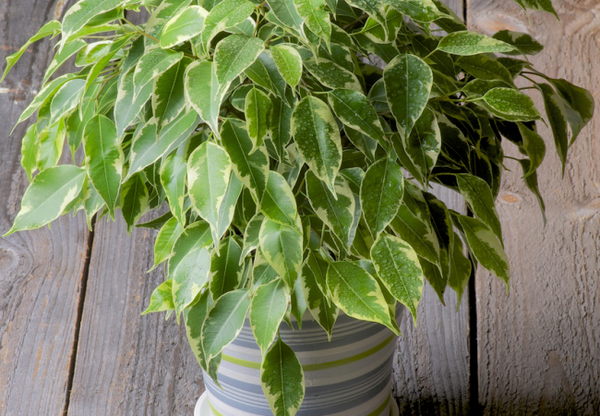
Temperature regime
One of the features of growing and caring for Benjamin's ficus is the creation of suitable temperature growing conditions. In order for the ficus to live longer and develop normally, temperatures throughout the year should not be lower than +16 and higher than +25 degrees. In summer, it is undesirable to keep plants in the heat, in winter, excessive cold should be prevented. Also, you should not install ficuses under the air conditioner or in a draft, because improper home care will either cause the leaves to fall or change the color of the leaves of the variegated variety (from green and white to pure white), which is not a sign of indoor Benjamin's health.
Irrigation Features
Since the homeland of this plant is a region with high humidity, many gardeners decide that Benjamin's ficus at home needs excessive watering. However, it is not. How many times a week to water Benjamin's ficus depends on numerous home care factors, including temperature, soil conditions, and the general humidity of the air in the room.
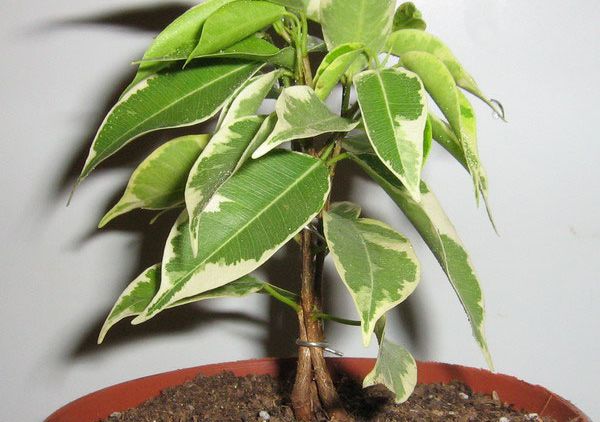
Frequent watering can damage the roots of the ficus or lead to white spots on the foliage, so first of all take care of the high-quality drainage system of the flower - it is best to have expanded clay at the bottom of the ficus pot.
Watering is carried out when the earth dries out by 1-2 cm. Regardless of the season, the plant should not be waterlogged, as this will either lead to root rot disease or white bloom on the sheets. You can water the grown flower only with settled soft water at room temperature (+23 degrees).
Comfortable humidity is achieved by spraying the plant daily. In addition, some plant growers practice a special way of caring for indoor ficuses: they lower the plant pot into the bath, cover it with polyethylene and pour water from a watering can or shower on top for 5 minutes. It is not necessary to do this home procedure often, but the Benjamins love it very much.
Top dressings and fertilizers
Planting and care in the future also include proper feeding plants. Fertilizers are especially important in the first months of growing Benjamin, when the ficus is just beginning to form, and it is most carefully looked after. In order for the flower to grow well for the first couple of years, in the first spring months after planting it is fed with special organic fertilizers every 4 weeks.
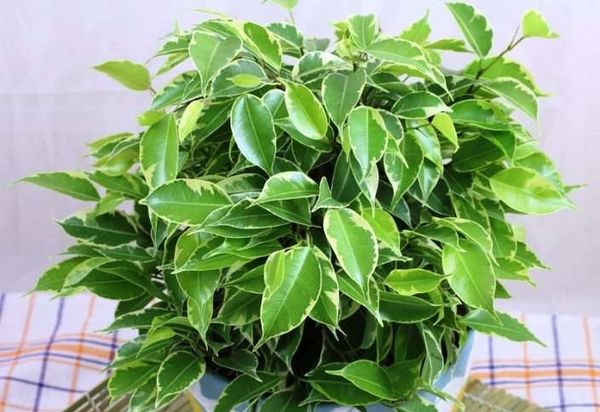
In May - early June, fertilizer will have to be applied once every 3 weeks, and in the summer, flower cultivation provides for mineral and organic top dressing once every 14 days. This is due to the fact that in a hot summer house, liquids from the soil, together with various useful minerals, evaporate 2 times faster, and therefore fertilizers must be applied more often. As the years pass, the flower needs less care, and, accordingly, top dressing. However, in order to grow a healthy ficus, the first years are very important.
plant pruning
At home, Benjamin's ficuses practically do not bloom, so you don't have to worry about pruning fruitful shoots. However, if you have grown a plant that blooms, you should not remove such shoots. How does a ficus bloom? Small flowers of syconia, from which inedible orange fruits grow.
In principle, this flower is able to develop and form a crown completely independently. However, it is not a sin to experiment with its form. To do this, the upper or side shoots are cut in the spring, depending on the expected shape. If you are growing several different trunks in one pot, then it is not necessary to cut them - just twist them together and install a backup. The shoots remaining after pruning can be used to breed the variety.
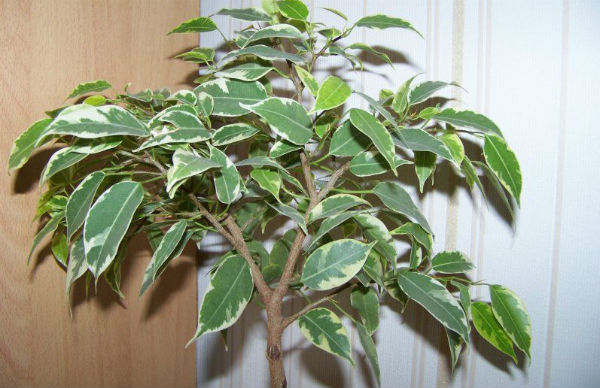
Growing problems
To choose the right system for how to plant and grow this species, it is important to know how fast Benjamin's ficus grows and how many years it lives. Until the “adult” age, ficuses are grown for approximately 1–1.5 years, and with good care they live for 10 and 15 years. However, the plant is susceptible to root rot, powdery mildew, aphids, spider mites and mealybugs. In solving these problems, timely disinfection with insecticides or treating the plant with laundry soap will help. Any problems with Benjamin are indicated by the appearance of a white coating on the sheets or their fall, which can be caused by a whole range of adverse factors: drafts, frequent rearrangements, dry air and other signs of a lack of proper plant care.
Video "Ficus Benjamin Transplant"
From this video you will learn how to properly transplant Benjamin's ficus.
So, the summer season, one might say, is already behind, and it becomes somehow sad. Summer flew by quickly, there were many things to do and worries. In the garden, in the garden, in the flower bed, the vast majority of work has already been completed, the garden is emptying. Most of the harvest has already been removed, packed and safely hidden. But you should not let yourself into waves of pessimism, because if you try and apply a little knowledge, you can extend autumn and return summer home by building it on the windowsill.
Sooner or later, any gardener faces the problem of neglected, overgrown, weed-affected areas. The task of clearing is connected not only with the situation when you acquire a suburban area in a deplorable state. Old flowerbeds or "forgotten" lawns, overgrown massifs or uncontrollably spreading weeds that were not started in time to deal with - the situation is not at all rare. And the main key to success in solving the problem is patience and endurance.
Pork Fajitas is a spicy Mexican appetizer recipe that consists of meat stew with vegetables, chili and a fresh salad. Traditionally, all the ingredients are wrapped in a round unleavened dough cake made from wheat or corn flour - a tortilla. In Mexico, fajita is served to the table separately - meat, vegetables and tortillas, and you yourself assemble your own version of the dish. Collect fajitas immediately before serving so that the tortilla does not get soggy.
Winter is the most critical period for apple trees and you need to survive it with minimal losses. In general, a set of measures includes the collection of a late harvest, the collection and destruction of fallen leaves, digging the near-trunk strip, fertilizing, water-charging irrigation, mulching the near-trunk zone, removing lichens and moss from trunks, stripping the bark, removing dry and interfering branches, whitewashing, processing from pests and diseases, sealing hollows and warming young apple trees.
One of the most beloved cultures that is used to create bonsai is the Japanese Serissa. This delightful plant is also called the tree of a thousand stars (its flowering fully justifies such a nickname). But Serissa has other advantages as well. Beautiful bark, miniature leaves, amazing silhouettes - all this more than compensates for its capriciousness. Growing serissa is not an easy task. But still, from indoor bonsai, it is considered one of the most unpretentious.
Mushroom soup with chanterelles - what could be tastier and easier. In my opinion, only champignons and oyster mushrooms compete with chanterelles in their availability and omnipresence. Even in the most “non-mushroom” year, there is a bucket of yellow “foxes” on the market. In addition to accessibility, there are a number of other benefits. Firstly, worms almost never infect this fungus. Secondly, you can collect a lot at once. Thirdly, you do not need to clean. In general, wherever you look - one solid benefit!
Strange, dazzlingly bright, outlandish, sloppy - what kind of epithets are not awarded to garden lichnis. These perennials combine winter hardiness and unpretentiousness with outlandish appearance. The culture has become one of the favorite species and is found both in trendy design projects and in private gardens. The main advantage of lychnis is undemanding care. Indeed, in order to admire the colors of the inflorescences, it is enough just not to forget about timely top dressing.
This article will focus on water-charging irrigation of fruit crops, which, I think, many gardeners neglect, especially in rainy autumn. It seems to many that the rain that thundered on the roof all night is able to wet the soil to a sufficient depth, and you can do without the use of additional artificial irrigation without spending extra money on water. But no, you can’t, and now we’ll tell you why and teach you how to properly recharge watering.
Zucchini marinated for the winter with onions, peppers and physalis - a light, spicy, assorted vegetable snack. Zucchini is a neutral vegetable, it perfectly absorbs various tastes and smells. A small handful of onions and sweet peppers, a little fragrant spices - that's all you need to make delicious canned vegetables. Physalis grew in my garden this year. Jam is made from it, however, in a pickled form, in my opinion, physalis is much tastier.
Soil is not just a habitat for plants. Along with carbon dioxide, light and water, it is a vital element without which most plants cannot survive. Soil characteristics, its mechanical composition, acidity, water and air permeability, nutritional value play a key role. Errors in the selection of the substrate are the source big problems and risks. The most reliable option for indoor plants are purchased, ready-made substrates.
Korean salad with cucumbers for the winter - a hot cold appetizer in a sweet and sour marinade. This recipe is not for sissies, as it contains quite a lot of hot peppers (this is precisely the highlight of the workpiece). Spicy vegetables will come in handy at the festive table or as a side dish for a meat dish, especially barbecue or fried chicken. For a Korean salad recipe with cucumbers and tomatoes, choose high-quality vegetables - small pimply cucumbers.
Few people know, but gooseberries are literally eternal and very productive culture. From a well-developed gooseberry bush, which you looked after properly, you can collect up to 15 kilograms of both tasty and large berries at the same time. So, let's first briefly list the activities that we need to carry out during the autumn period with gooseberry bushes, and then we will describe each of them in detail so that you have an idea of \u200b\u200bwhat and how to do it.
Primroses are plants that perfectly match the concept of a “lazy” garden. They are unpretentious, undemanding to care, they can settle even where, it would seem, there is no place for primroses at all. Equally beautiful leaves and bloom - nice bonus for plants that can be “planted and forgotten”. True, it is not possible to say that they grow on their own about all primroses. But there are many species that allow you to create beautifully flowering accents, simplifying the care of the garden.
Meatballs with tomato and sweet pepper gravy are a classic dish that many have loved since childhood. No matter how the pork cutlets are called: meat balls, minced hedgehogs, meatballs or meatballs, as in this recipe, the essence does not change. A juicy cutlet in a fragrant thick sauce looks so appetizing that everyone salivates without exception. You can add cream or sour cream to the gravy for meatballs and thicken it with flour, but it is better to add more vegetables.
There have been, are and will be disputes around the digging of the near-stem circle of fruit trees for a very long time, probably as long as gardens exist. Options for the content of the near-trunk circle fruit tree quite a lot, there is black steam (namely, digging), and turfing, and mulching, and each of these activities has both pros and cons. Digging the soil in the near-stem strip and mulching can be combined, including here also watering and fertilizing.
It is not by chance that palm trees have won leadership among indoor giants. Beautiful, strict and elegant at the same time, they bring clean lines and a tropical mood to homes for decades. And although the belonging of plants to palm trees is determined at a glance, the palm family is far from homogeneous. And first of all - by its exactingness and capriciousness. Among indoor palms, there are both unpretentious and species, the cultivation of which is only possible for the elite.